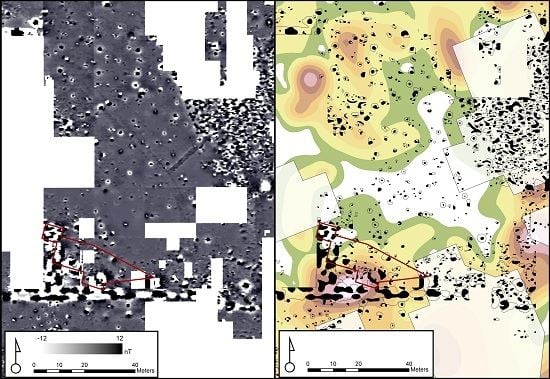The Archaeology and Remote Sensing of Santa Elena’s Four Millennia of Occupation
Abstract
1. Introduction
2. The Santa Elena Landscape
2.1. Native American Histories
2.2. Spanish Colonial Period
2.3. Santa Elena’s Post-Spanish Occupation
3. The Santa Elena Landscape Project
4. Materials and Methods
4.1. Shovel Test Survey, Global Positioning Systems (GPS), and Geographic Information Systems (GIS)
4.2. LiDAR
4.3. Resistance Survey
4.4. Gradiometer Survey
4.5. GPR
5. Results
5.1. Late Archaic-Early/Middle Woodland
5.2. Late Woodland-Mississippian/Post-Spanish Native American Occupation
5.3. Spanish Colonial
5.4. The Antebellum and Postbellum Periods
6. Discussion
6.1. Four Millennia of Occupation at Santa Elena
6.2. Implications for Research Methods
- Remote sensing data and close-interval shovel testing surveys provide complimentary, but independent, datasets by which the changing nature of space and architecture can be evaluated in high-resolution.
- Even when cultural features (e.g., houses, walls) are clearly discernible in remote sensing data, shovel test data provide information on the distribution of geophysically invisible activity areas that can then be connected to more formal features.
- Shovel testing on a close (<10 m), fixed interval grid provides a different kind of “ground truthing” than what is traditionally employed. Instead of placing units directly over a given “anomaly,” shovel testing can provide a much more complete context for the interpretation of the relationships between anomalies and identifiable culture features, including spaces that contain no signatures in the remote sensing data. Thus, while traditional ground truthing only tests identifiable patterns and signals in the data, fixed interval shovel testing provides information on how these signals articulate with one another given the distribution of activities across the site, including areas that may be avoided or kept clean of refuse and other features.
- Given that the usual employment of ground-based instruments provides mostly two-dimensional datasets, shovel testing, especially ones that are excavated in levels, provide information on the distribution of artifacts and features at varying depths. For sites with long-term histories this is especially important as it allows researchers to tease apart which patterns in geophysical data are associated with specific components.
- Although researchers often use GPR on a much smaller scale than other methods, we found that a large-scale GPR survey and close-interval shovel tests, excavated in levels, provide perhaps one of the best ways to evaluate space and architecture at multi-component sites. The reason for this is that both datasets provide information not only on the horizontal distribution of features and artifacts, but also their vertical position vis-à-vis one another. Admittedly, a large-scale GPR survey and shovel testing at close intervals over an entire site, especially a large one, are perhaps some of the more labor-intensive methods of archaeological survey. Nevertheless, our estimate is that, in many cases, this is well worth the cost in time and funds.
6.3. Management Implications and Recommendations
7. Conclusions
Acknowledgments
Author Contributions
Conflicts of Interest
References
- Thompson, V.D.; DePratter, C.B.; Roberts Thompson, A.D. Defining Santa Elena’s Colonial Landscape through Shallow Geophysics. J. Archaeol. Sci. Rep. 2016, 9, 178–190. [Google Scholar]
- Manucy, A. Report on Relics from 1923 Excavation of Fortification Site on Parris Island, South Carolina; National Park Service: St. Augustine, FL, USA, 1957.
- Osterhout, G. After Three Hundred and Fifty Years—Being the Story of Charles’ Fort, Built by Jean Ribault in 1562 on What Is now Known as Parris Island, South Carolina; Marine Corps Association: Quantico, VA, USA, 1923; pp. 98–109. [Google Scholar]
- Rowland, L.S.; Wise, S.R. Bridging the Sea Islands’ Past and Present, 1893–2006: The History of Beaufort County, South Carolina; University of South Carolina Press: Columbia, SC, USA, 2015; Volume 3. [Google Scholar]
- Salley, A.S., Jr. The Spanish Settlementat Port Royal, 1565–1586. South Carol. Hist. Geneal. Mag. 1925, 26, 31–40. [Google Scholar]
- Salley, A.S., Jr. The Site of Charlesfort. In The Whole and True Discovery of Florida; Connor, J.T., Ed.; Florida State Hsitorical Society: Deland, FL, USA, 1927; pp. 113–124. [Google Scholar]
- South, S. A Search for the French Charlesfort of 1562; South Carolina Institute of Archaeology and Anthropology Resarch Manuscript 177; University of South Carolina: Columbia, SC, USA, 1982. [Google Scholar]
- South, S. Exploring Santa Elena 1981; South Carolina Institute of Archaeology and Anthropology Research Manuscript 184; University of South Carolina: Columbia, SC, USA, 1982. [Google Scholar]
- South, S. Revealing Santa Elena 1982; South Carolina Institute of Archaeology and Anthropology Research Manuscript Series 188; University of South Carolina: Columbia, SC, USA, 1983. [Google Scholar]
- South, S. Testing Archaeological Sampling Methods at Fort San Felipe 1983; South Carolina Institute of Archaeology and Anthropology Research Manuscript Series 190; University of South Carolina: Columbia, SC, USA, 1984. [Google Scholar]
- South, S. Excavation of the Casa Fuerte and Wells at Fort San Felipe 1984; South Carolina Institute of Archaeology and Anthropology Research Manuscript Series 196; University of South Carolina: Columbia, SC, USA, 1985. [Google Scholar]
- South, S.; DePratter, C.B. Discovery at Santa Elena: Block Excavation 1993; South Carolina Institute of Archaeology and Anthropology Research Manuscript Series 222; University of South Carolina: Columbia, SC, USA, 1996. [Google Scholar]
- Wise, S.R.; Rowland, L.S. Rebellion, Reconstruction, and Redemption, 1861–1893; University of South Carolina Press: Columbia, SC, USA, 2015; Volume 2. [Google Scholar]
- Sanger, M.C. Leaving the rings: Shell ring abandonment and the end of the Late Archaic. In Trend, Tradition, and Turmoil: What Happened to the Southeastern Archaic; Thomas, D.H., Sanger, M., Eds.; American Museum of Natural History Anthropological Papers, Number 93; American Museum of Natural History: New York, NY, USA, 2010; pp. 201–216. [Google Scholar]
- Sanger, M.C. Life in the Round: Shell Rings of the Georgia Bight; Columbia University: New York, NY, USA, 2015. [Google Scholar]
- Thomas, D.H. “What happened to the southeastern Archaic?” A perspective from St. Catherines Island. In Trend, Tradition, and Turmoil: What Happened to the Southeastern Archaic; Thomas, D.H., Sanger, M., Eds.; Anthropological Papers; American Museum of Natural History: New York, NY, USA, 2010; pp. 173–199. [Google Scholar]
- Thompson, V.D.; Worth, J.E. Dwellers by the Sea: Native American Adaptations along the Southern Coasts of Eastern North America. J. Archaeol. Res. 2011, 19, 51–101. [Google Scholar] [CrossRef]
- DePratter, C.B. Shellmound Archaic on the Georgia Coast. South Carol. Antiq. 1979, 11, 1–69. [Google Scholar]
- DePratter, C.B. Thoughts on the Late Archaic-Early Woodland Transition on the Georgia and South Carolina Coasts. In Trend, Tradition, and Turmoil: What Happened to the Southeastern Archaic; Thomas, D.H., Sanger, M.C., Eds.; Anthropological Papers, Number 93; American Museum of Natural History: New York, NY, USA, 2010; pp. 247–252. [Google Scholar]
- Thompson, V.D. The rhythms of space-time and the making of monuments and places during the Archaic. In Trend, Tradition, and Turmoil: What Happened to the Southeastern Archaic; Thomas, D.H., Sanger, M.C., Eds.; Anthropological Papers, Number 93; American Museum of Natural History: New York, NY, USA, 2010; pp. 217–227. [Google Scholar]
- Thompson, V.D.; Andrus, C.F.T. Evaluating Mobility, Monumentality, and Feasting at the Sapelo Island Shell Ring Complex. Am. Antiq. 2011, 76, 315–343. [Google Scholar] [CrossRef]
- Thompson, V.D.; Turck, J.A. Adaptive Cycles of Coastal Hunter-Gatherers. Am. Antiq. 2009, 74, 255–278. [Google Scholar] [CrossRef]
- Turck, J.A.; Thompson, V.D. Revisiting the Resilience of Late Archaic Hunter-gatherers along the Georgia Coast. J. Anthropol. Archaeol. 2016, 43, 39–55. [Google Scholar] [CrossRef]
- Thomas, D.H. Native American Landscapes of St. Catharines Island, Georgia, Vol. III. Synthesis and Implications; Anthropological Papers, Number 88; American Museum of Natural History: New York, NY, USA, 2008. [Google Scholar]
- Pluckhahn, T.J.; McKivergan, D.A. A Critical Appraisal of Middle Mississippian Settlement and Social Organization on the Georgia Coast. Southeast. Archaeol. 2002, 21, 149–161. [Google Scholar]
- Thompson, V.D. The Mississippian Production of Space through Earthen Pyramids and Public Buildings on the Georgia Coast, USA. World Archaeol. 2009, 41, 445–470. [Google Scholar] [CrossRef]
- DePratter, C.B. W.P.A. Archaeological Excavations in Chatham County, Georgia: 1937–1942; Series No. 29; Univerity of Georgia, Laboratory of Archaeology: Athens, Georgia, 1991. [Google Scholar]
- Ritchison, B.T. Exploring a Bayesian method for examining the regional ceramic sequence along the Georgia Coast. Southeast. Archaeol. 2017, 1–10. [Google Scholar] [CrossRef]
- DePratter, C.B. Irene and Altamaha Ceramics from the Charlesfort/Santa Elena Site, Parris Island, South Carolina. In From Santa Elena to St. Augustine: Indigenous Ceramic Variability (AD1400-1700); Deagan, K., Thomas, D.H., Eds.; Anthropological Papers, Number 90; American Museum of Natural History: New York, NY, USA, 2009; pp. 19–48. [Google Scholar]
- Thompson, V.D.; Turck, J.A. Island Archaeology and the Native American Economies (2500 B.C.-A.D. 1700) of the Georgia Coast. J. Field Archaeol. 2010, 35, 283–297. [Google Scholar] [CrossRef]
- Hutchinson, D.L.; Larsen, C.S.; Schoeninger, M.J.; Norr, L. Regional variation in the pattern of maize adoption and use in Florida and Georgia. Am. Antiq. 1998, 63, 397–416. [Google Scholar] [CrossRef]
- Larsen, C.S.; Griffin, M.C.; Hutchinson, D.L.; Noble, V.E.; Norr, L.; Pastor, R.F.; Ruff, C.B.; Russell, K.F.; Schoeninger, M.J.; Schultz, M. Frontiers of contact: Bioarchaeology of Spanish Florida. J. World Prehist. 2001, 15, 69–123. [Google Scholar] [CrossRef]
- DePratter, C.B.; South, S. Discovery at Santa Elena: Boundary Survey; South Carolina Institute of Archaeology and Anthropology Research Manuscript Series 221; University of South Carolina: Columbia, SC, USA, 1995. [Google Scholar]
- Hoffman, P.E. A New Andalucia and a Way to the Orient: The American Southeast during the Sixteenth Century; LSU Press: Baton Rouge, LA, USA, 1990. [Google Scholar]
- Hoffman, P.E. Florida’s Frontiers; Indiana University Press: Bloomington, IN, USA, 2001. [Google Scholar]
- Lyon, E. The Enterprise of Florida: Pedro Menéndez de Avilés and the Spanish Conquest of 1565–1568; University Presses of Florida: Gainesville, FL, USA, 1983. [Google Scholar]
- Lyon, E. Santa Elena: A Brief History of the Colony; South Carolina Institute of Archaeology and Anthropology Research Manuscript Series 193; University of South Carolina: Columbia, SC, USA, 1984. [Google Scholar]
- McGrath, J.T. The French in Early Florida: In the Eye of the Hurricane; University Press of Florida: Gainesville, FL, USA, 2000. [Google Scholar]
- DePratter, C.B.; South, S.; Legg, J.B. The Discovery of Charlesfort. Trans. Huguenot Soc. South Carol. 1996, 101, 39–48. [Google Scholar]
- Connor, J.T. Colonial Records of Spanish Florida-Volume 1: 1570–1577; Florida State Historical Society: Cocoa, FL, USA, 1925. [Google Scholar]
- Hilton, W. Narrative of Discovery. In Narratives of Early Carolina (1650–1708); Salley, A.S., Jr., Ed.; Charles Scribner’ss Sons: New York, NY, USA, 1911; pp. 31–61. [Google Scholar]
- Worth, J.E. The Struggle for the Georgia Coast: An Eighteenth-Century Spanish Retrospective on Guale and Mocama; Anthropological Papers, Number 75; American Museum of Natural History: New York, NY, USA, 1995. [Google Scholar]
- Legg, J.B. The Great War at Santa Elena: The Incidental Archaeology of World War I Marine Corps training on Parris Island. In Praise of the Poet Archaeologist: Papers in Honor of Stanley South and His Five Decades of Historical Archaeology; Carnes-McNaughton, L.F., Steen, C., Eds.; Council of South Carolina Professional Archaeologists: Columbia, SC, USA, 2005; Volume 1, pp. 120–140. [Google Scholar]
- Harmon, J.M.; Leone, M.P.; Prince, S.D.; Snyder, M. Lidar for archaeological landscape analysis: A case study of two eighteenth-century Maryland plantation sites. Am. Antiq. 2006, 71, 649–670. [Google Scholar] [CrossRef]
- Gallagher, J.M.; Josephs, R.L. Using LiDAR to detect cultural resources in a forested environment: An example from Isle Royale National Park, Michigan, USA. Archaeol. Prospect. 2008, 15, 187–206. [Google Scholar] [CrossRef]
- Pluckhahn, T.J.; Thompson, V.D. Integrating LiDAR data and conventional mapping of the Fort Center site in south-central Florida: A comparative approach. J. Field Archaeol. 2012, 37, 289–301. [Google Scholar] [CrossRef]
- Thompson, V.D. Conceptualizing Anthropogenic Islands through LiDAR in Southern Florida. In New Approaches to Anthropological Remote Sensing; McKinnon, D., Haley, B.S., Eds.; The University of Alabama Press: Tuscaloosa, AL, USA, 2017; pp. 127–140. [Google Scholar]
- Thompson, V.D.; Marquardt, W.H.; Walker, K.J. A remote sensing perspective on shoreline modification, canal construction and household trajectories at Pineland along Florida’s southwestern Gulf Coast. Archaeol. Prospect. 2014, 21, 59–73. [Google Scholar] [CrossRef]
- Ackermann, F. Airborne laser scanning—Present status and future expectations. ISPRS J. Photogramm. Remote Sens. 1999, 54, 64–67. [Google Scholar] [CrossRef]
- Doneus, M.; Briese, C.; Fera, M.; Janner, M. Archaeological prospection of forested areas using full-waveform airborne laser scanning. J. Archaeol. Sci. 2008, 35, 882–893. [Google Scholar] [CrossRef]
- Kvamme, K.L. Magnetometry: Nature’s gift to archaeology. In Remote Sensing in Archaeology: An Explicitly North American Perspective; Johnson, J.K., Ed.; The University of Alabama Press: Tuscaloosa, AL, USA, 2006; pp. 251–268. [Google Scholar]
- Gater, J.; Gaffney, C. Revealing the Buried Past: Geophysics for Archaeologists; Tempus: Wiltshire, UK, 2003. [Google Scholar]
- Sommers, L. Resistivity Survey. In Remote Sensing in Archaeology: An Explicitly North American Perspective; Johnson, J.K., Ed.; University of Alabama Press: Tuscaloosa, AL, USA, 2006; pp. 109–130. [Google Scholar]
- Bigman, D.P.; Lanzarone, P.M. Investigating Construction History, Labour Investment and Social Change at Ocmulgee National Monument’s Mound A, Georgia, USA, Using Ground-penetrating Radar. Archaeol. Prospect. 2014, 21, 213–224. [Google Scholar] [CrossRef]
- Bigman, D.P.; King, A.; Walker, C.P. Recent geophysical investigations and new interpretations of Etowah’s Palisade. Southeast. Archaeol. 2011, 30, 38–50. [Google Scholar] [CrossRef]
- Burks, J. Geophysical survey at Ohio earthworks: Updating nineteenth century maps and filling the ‘empty’ spaces. Archaeol. Prospect. 2014, 21, 5–13. [Google Scholar] [CrossRef]
- Burks, J.; Cook, R.A. Beyond Squier and Davis: Rediscovering Ohio’s earthworks using geophysical remote sensing. Am. Antiq. 2011, 76, 667–689. [Google Scholar] [CrossRef]
- Davis, J.R.; Walker, C.P.; Blitz, J.H. Remote sensing as community settlement analysis at Moundville. Am. Antiq. 2015, 80, 161–169. [Google Scholar] [CrossRef]
- Gaffney, C.F.; Gaffney, V.; Neubauer, W.; Baldwin, E.; Chapman, H.; Garwood, P.; Moulden, H.; Sparrow, T.; Bates, R.; Löcker, K. The Stonehenge hidden landscapes project. Archaeol. Prospect. 2012, 19, 147–155. [Google Scholar] [CrossRef]
- Haley, B.S. The big picture at Hollywood: Geophysical and archaeological investigations at a Mississippian mound centre. Archaeol. Prospect. 2014, 21, 39–47. [Google Scholar] [CrossRef]
- Kvamme, K.L. Geophysical surveys as landscape archaeology. Am. Antiq. 2003, 68, 435–457. [Google Scholar] [CrossRef]
- Kvamme, K.L. Archaeological prospecting at the double ditch state historic site, North Dakota, USA. Archaeol. Prospect. 2008, 15, 62–79. [Google Scholar] [CrossRef]
- Conyers, L.B. Ground-penetrating radar for landscape archaeology: Method and applications. In Seeing the Unseen; Campana, S., Piro, S., Eds.; Taylor and Francis: London, UK, 2006; pp. 245–255. [Google Scholar]
- Conyers, L.B. Ground-penetrating radar for anthropological research. Antiquity 2010, 84, 175–184. [Google Scholar] [CrossRef]
- Conyers, L.B. Interpreting Ground-Penetrating Radar for Archaeology; Left Coast Press: Walnut Creek, CA, USA, 2012. [Google Scholar]
- Conyers, L.B. Ground-Penetrating Radar for Geoarchaeology; John Wiley & Sons: Hoboken, NJ, USA, 2016. [Google Scholar]
- Conyers, L.B. Ground-Penetrating Radar and Magnetometry for Buried Landscape Analysis; Springer Press: Cham, Switzerland, 2017. [Google Scholar]
- Gragson, T.L.; Thompson, V.D.; Leigh, D.S.; Hautefeuille, F. Ground penetrating radar data used in discovery of the early Christian church of Notre Dame de Baudes near Labastide-du-Temple, France. Data Brief 2016, 7, 1588–1593. [Google Scholar] [CrossRef] [PubMed]
- Thompson, V.D.; Pluckhahn, T.J. History, complex hunter-gatherers, and the mounds and monuments of Crystal River, Florida, USA: A geophysical perspective. J. Island Coast. Archaeol. 2010, 5, 33–51. [Google Scholar] [CrossRef]
- Russo, M. Ringed shell features of the southeast United States: Architecture and midden. In The Cultural Dynamics of Shell-Matrix Sites; Roksanndik, M., Mendonça de Souza, S., Eggers, S., Burchell, M., Klokler, D., Eds.; University of New Mexico Press: Albuquerque, NM, USA, 2014; pp. 21–39. [Google Scholar]
- Crook, M.R. Mississippi Period Archaeology of the Georgia Coastal Zone; Series No. 23; University of Georgia, Laboratory of Archaeology: Athens, Georgia, 1986. [Google Scholar]
- DePratter, C.B. An Archaeological Survey of Ossabaw Island, Chatham County, Georgia: Preliminary Report; Report on File at the University of Georgia, Laboratory of Archaeology; University of Georgia, Laboratory of Archaeology: Athens, Georgia, 1974. [Google Scholar]
- DePratter, C.B. Environmental Changes on the Georgia Coast during the Prehistoric Period. Early Ga. 1977, 5, 1–14. [Google Scholar]
- Pearson, C.E. Prehistoric Settlement and Sites on Ossabaw Island, Georgia: An Atlas; Manuscript 614; University of Georgia, Laboratory of Archaeology: Athens, Georgia, 2014. [Google Scholar]
- DePratter, C.B.; Legg, J.B.; South, S. “Gone but Not Forgotten” African American Cemeteries on the United States Marine Corps Recruit Depot, Parris Island, South Carolina; South Carolina Institute of Archaeology and Anthropology Research Manuscript Series 234; University of South Carolina: Columbia, SC, USA, 2016. [Google Scholar]
- Bailey, G. Time perspectives, palimpsests and the archaeology of time. J. Anthropol. Archaeol. 2007, 26, 198–223. [Google Scholar] [CrossRef]
- Burks, J. The Highland County Gist Settlement (33HI417): Archaeological Investigation into the Results of Manumission at a Settlement of Freedmen in Southern Ohio; Contract Report #2014-03; Ohio Valley Archaeology, Inc.: Columbus, OH, USA, 2016. [Google Scholar]
- Pecora, A.M.; Burks, J. Phase II Archaeological Assessments of Sites 33DL1831 and 33DL1837, Delaware County, Ohio; Ohio Valley Archaeology, Inc.: Columbus, OH, USA, 2006. [Google Scholar]
- Pecora, A.M.; Burks, J. Phase III Archaeological Data Recovery of Site 33DL1837, Delaware County, Ohio; Ohio Valley Archaeology, Inc.: Columbus, OH, USA, 2007. [Google Scholar]
- Pecora, A.M.; Burks, J. Phase II Archaeological Assessment of the Manns Site (33LE736) within the Proposed 80-Acre Riverwalk Planned Community and Marina near Proctorville, Union Township, Lawrence County, Ohio; Ohio Valley Archaeology, Inc.: Columbus, OH, USA, 2008. [Google Scholar]
- Cook, R.A.; Burks, J. Determining Site Size and Structure in Cases of Low Surface Visibility: A Fort Ancient Example. Am. Antiq. 2011, 76, 145–162. [Google Scholar] [CrossRef]
- Meyers, M. Political Economy of Exotic Trade on the Mississippian Frontier: A Case Study of a Fourteenth Century Chiefdom in Southwestern Virginia; University of Kentucky: Lexington, KY, USA, 2011. [Google Scholar]
- Intergovernmental Panel on Climate Change. Climate Change 2014: Synthesis Report; IPCC: Geneva, Switzerland, 2014. [Google Scholar]
- DePratter, C.B.; South, S. Charlesfort: The 1989 Search Project; South Carolina Institute of Archaeology and Anthropology Research Manuscript Series 210; University of South Carolina: Columbia, SC, USA, 1990. [Google Scholar]
- Martindale, A.; Letham, B.; McLaren, D.; Archer, D.; Burchell, M.; Schöne, B.R. Mapping of subsurface shell midden components through percussion coring: Examples from the Dundas Islands. J. Archaeol. Sci. 2009, 36, 1565–1575. [Google Scholar] [CrossRef]
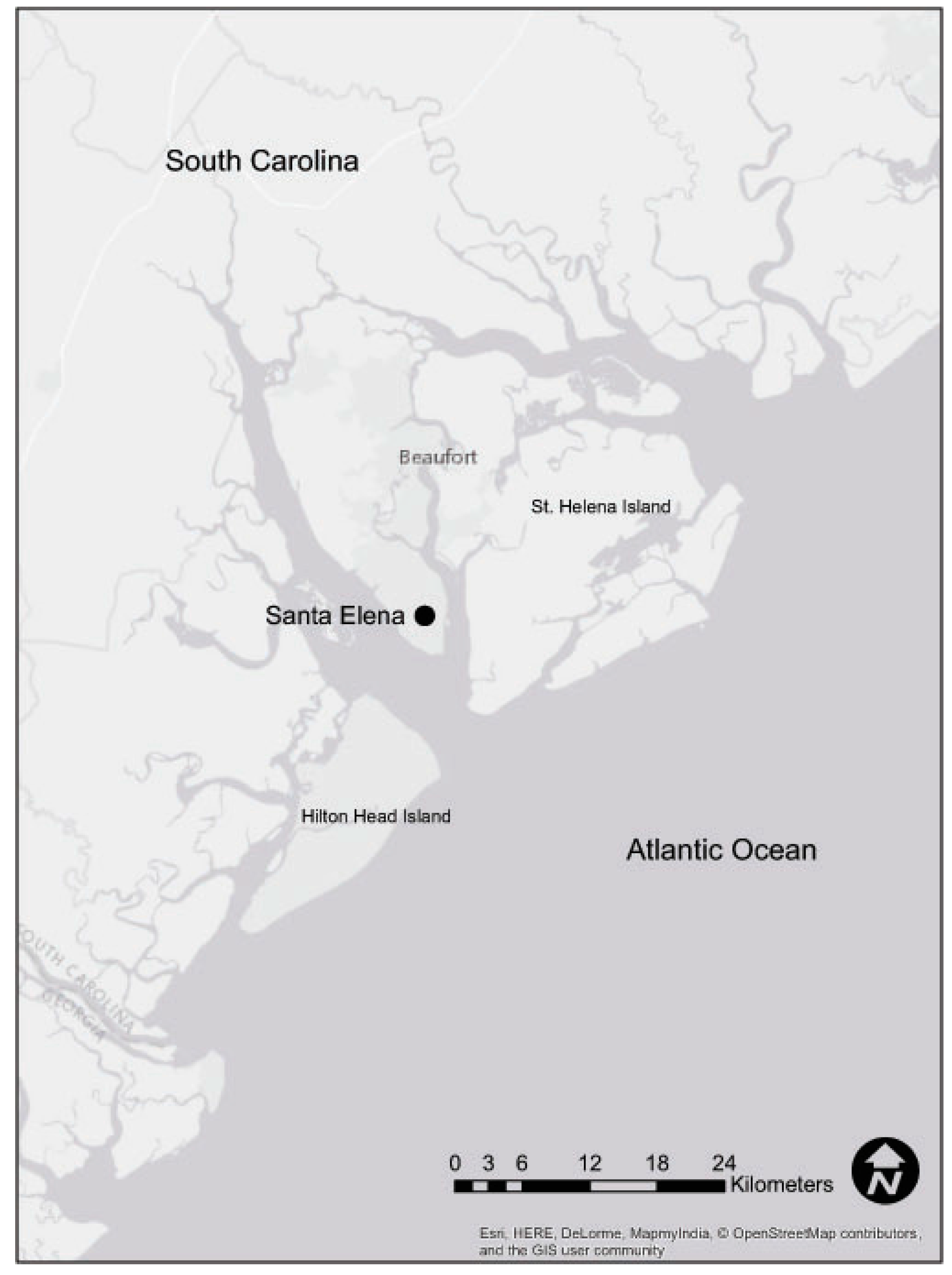
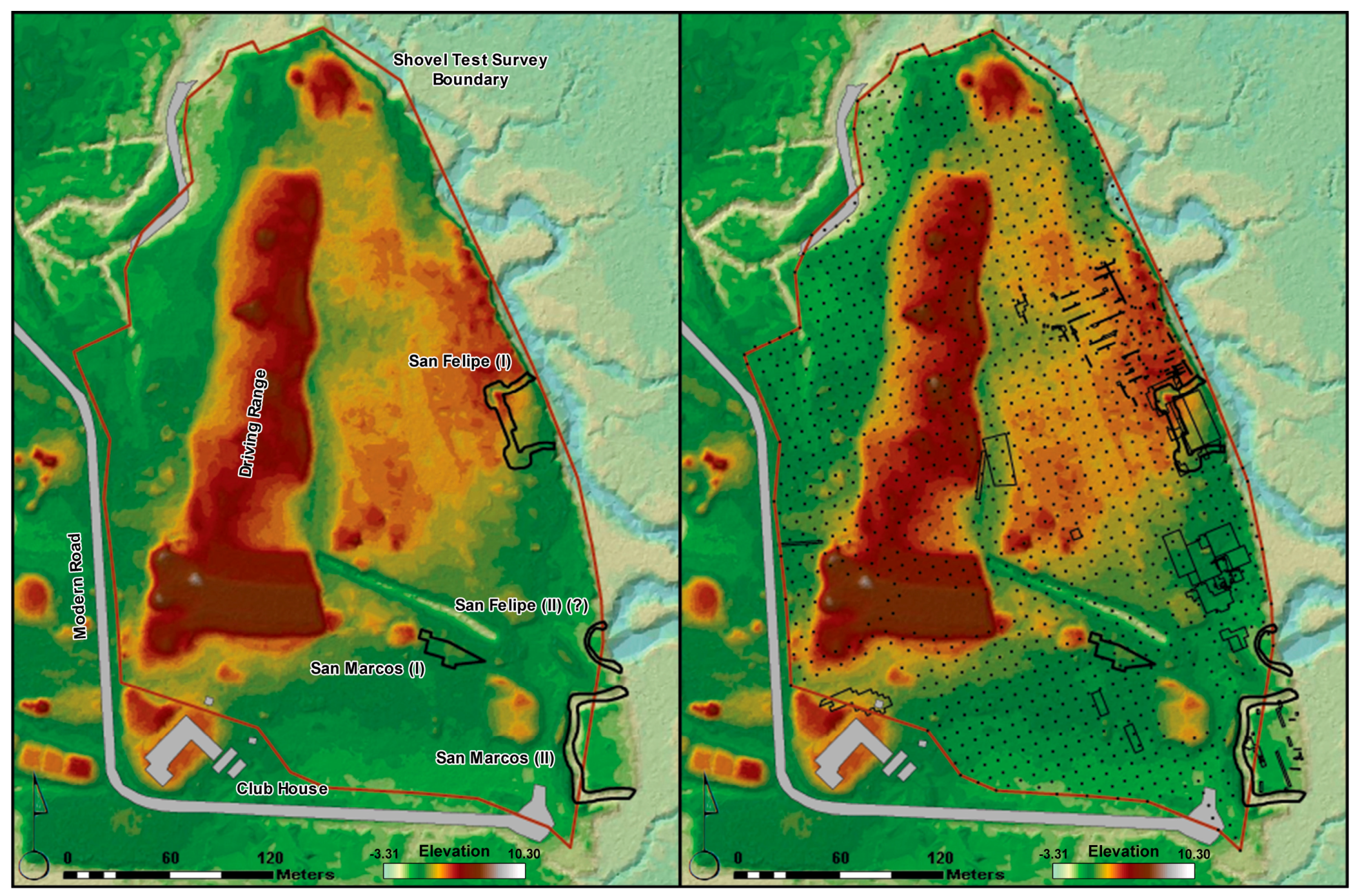
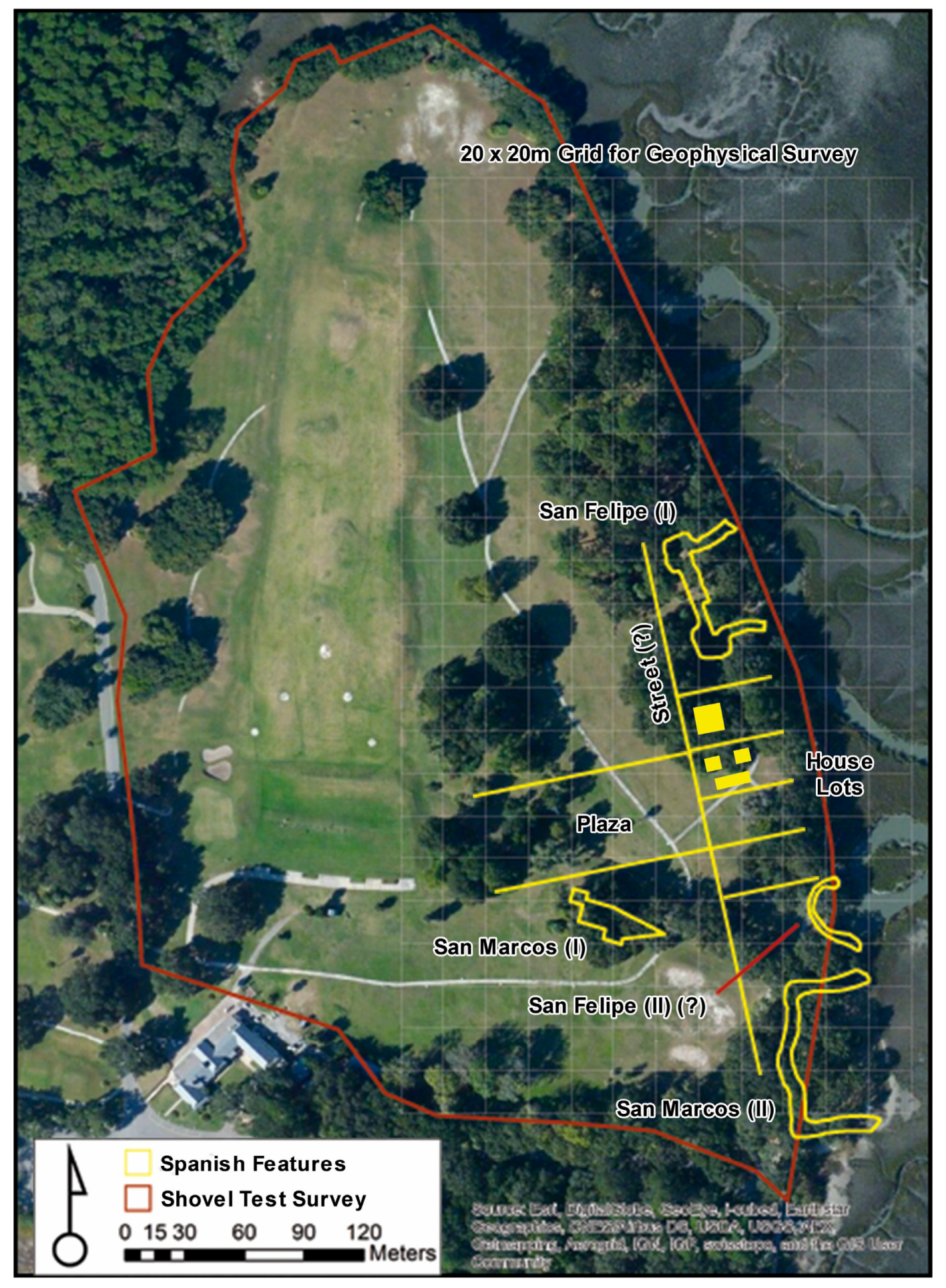
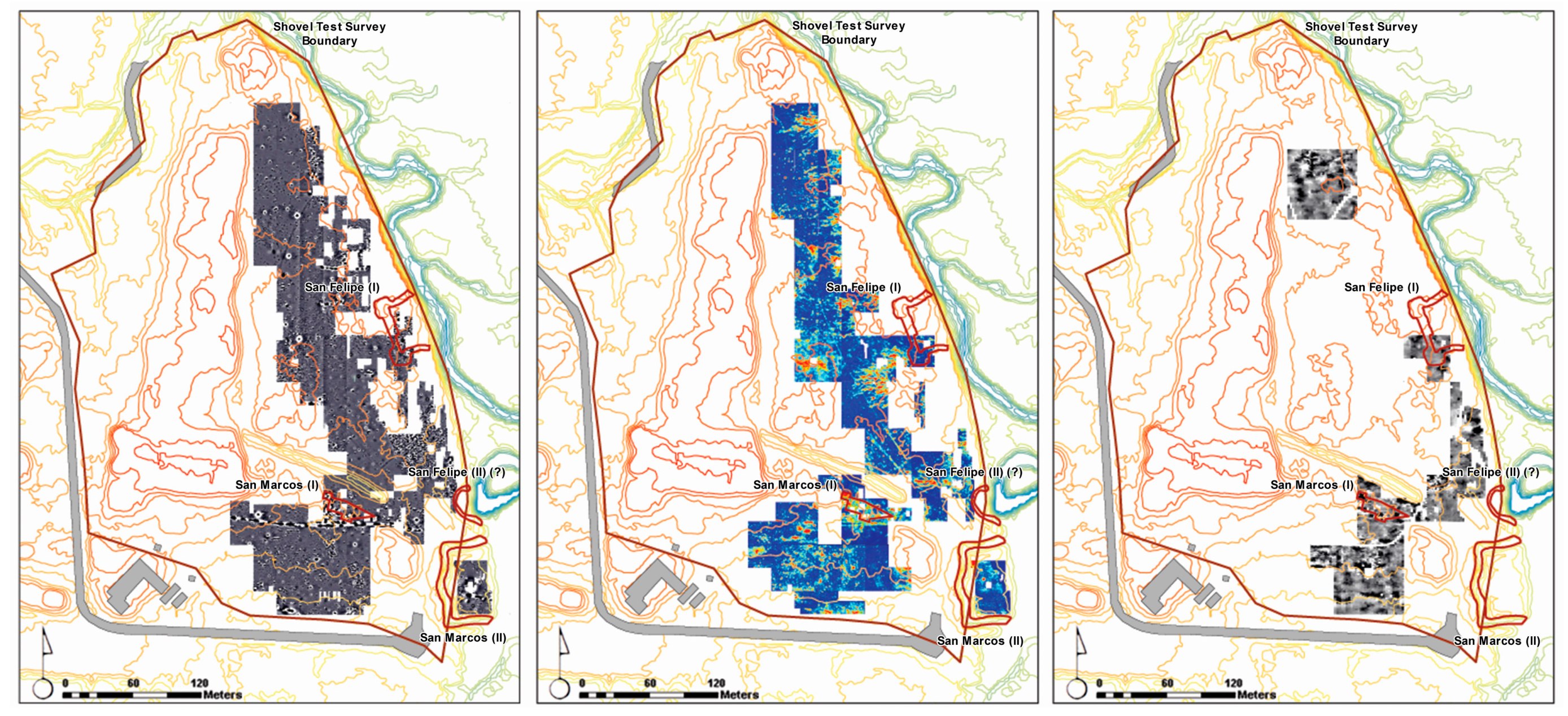
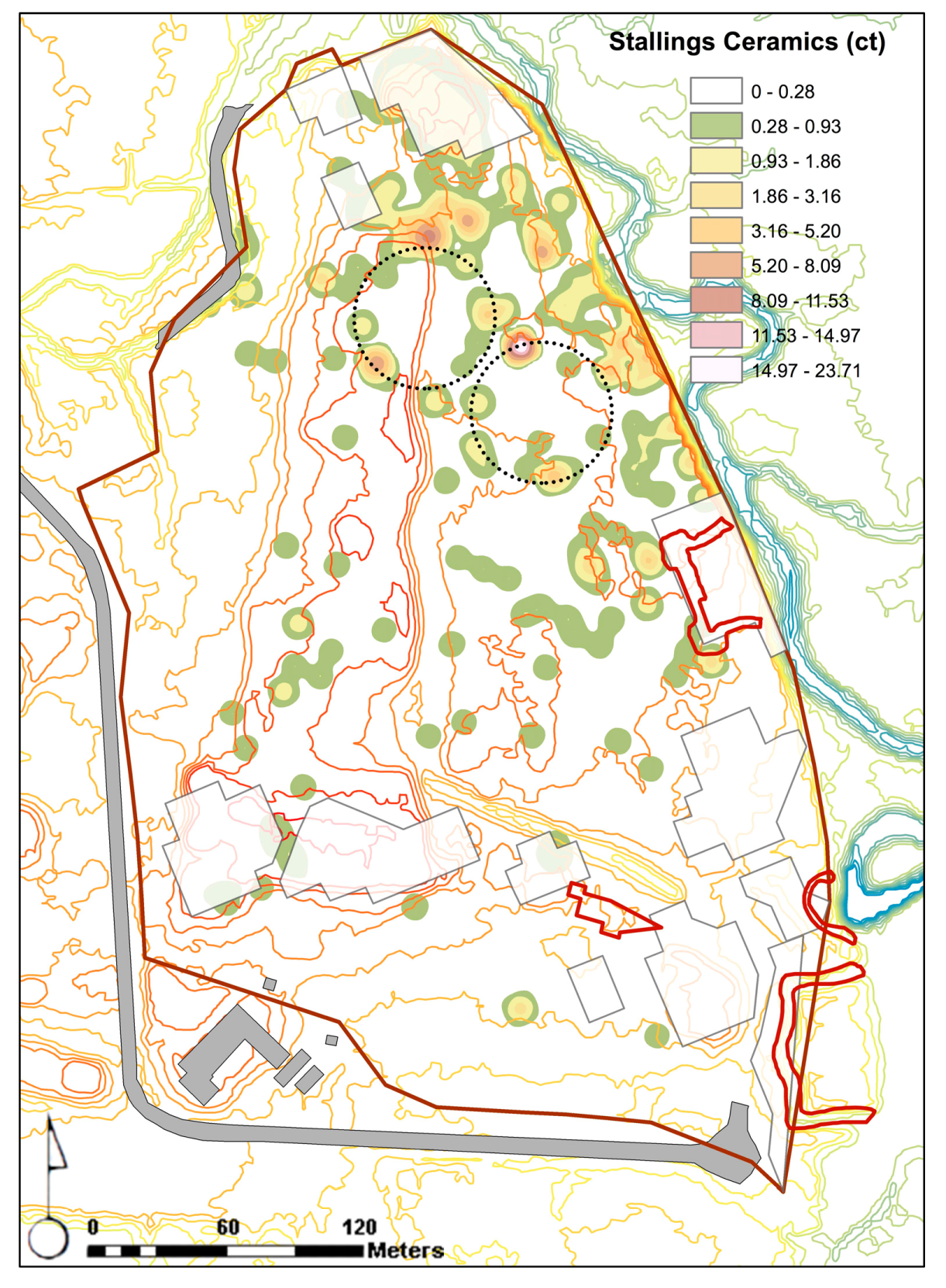
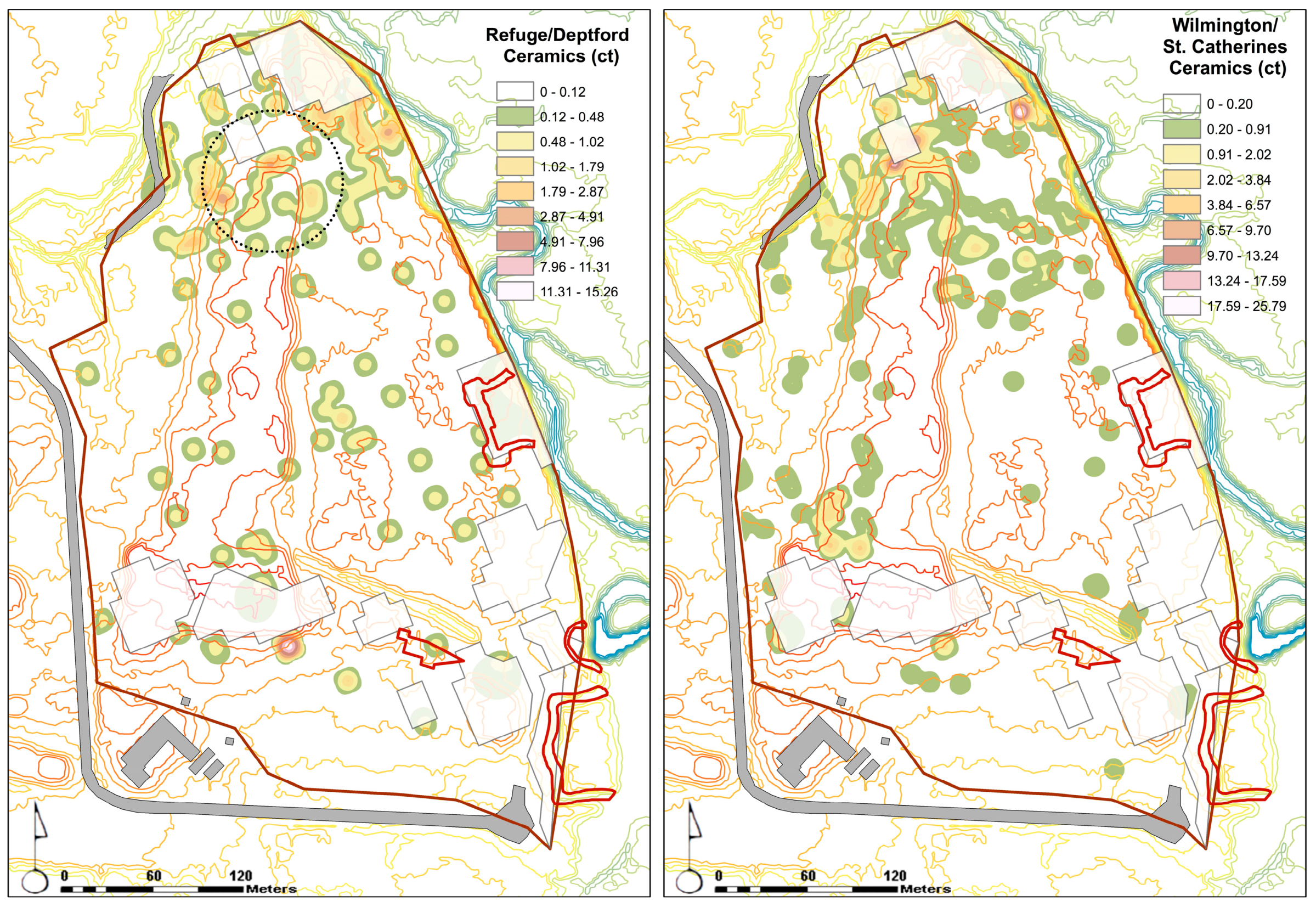
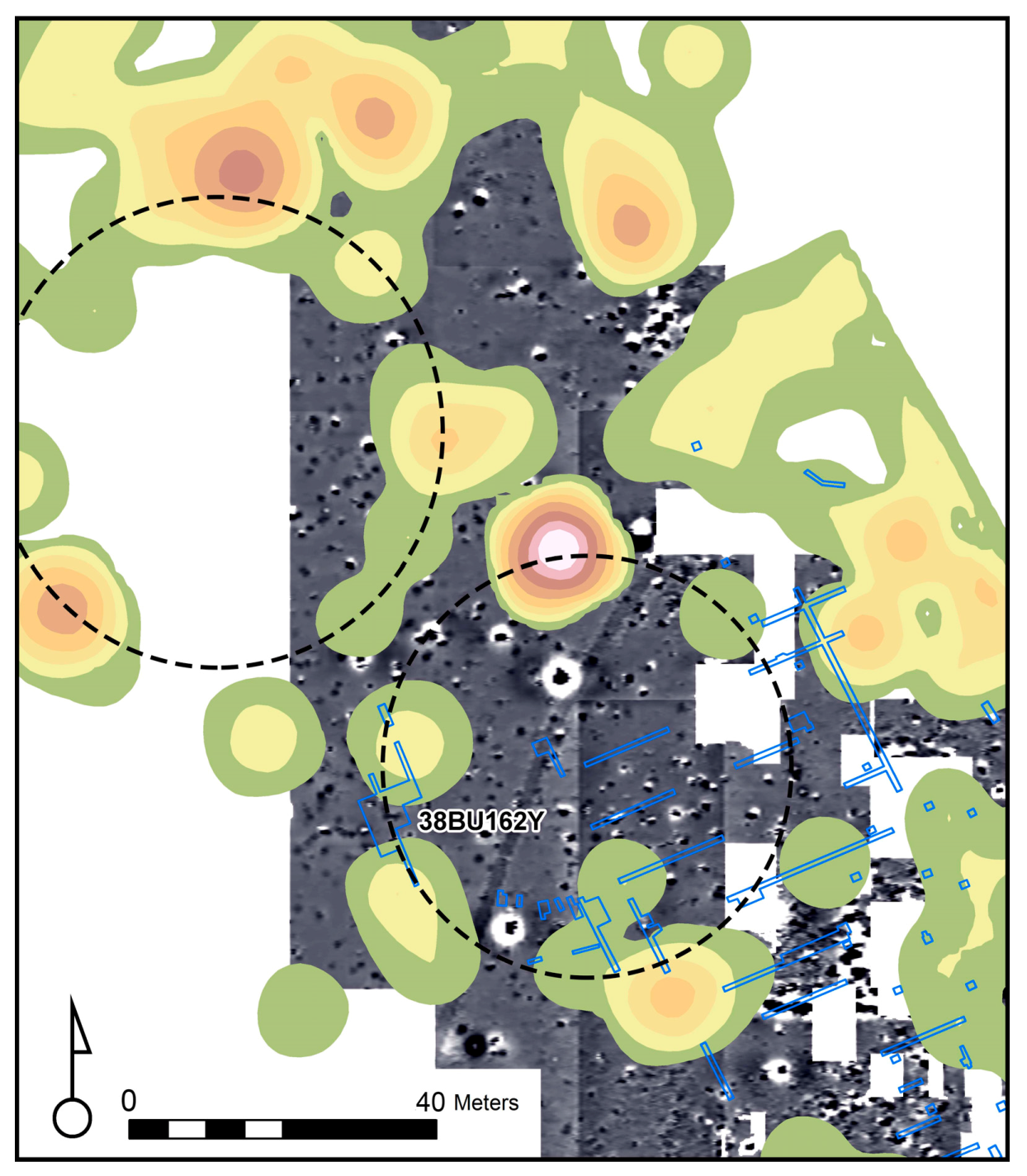
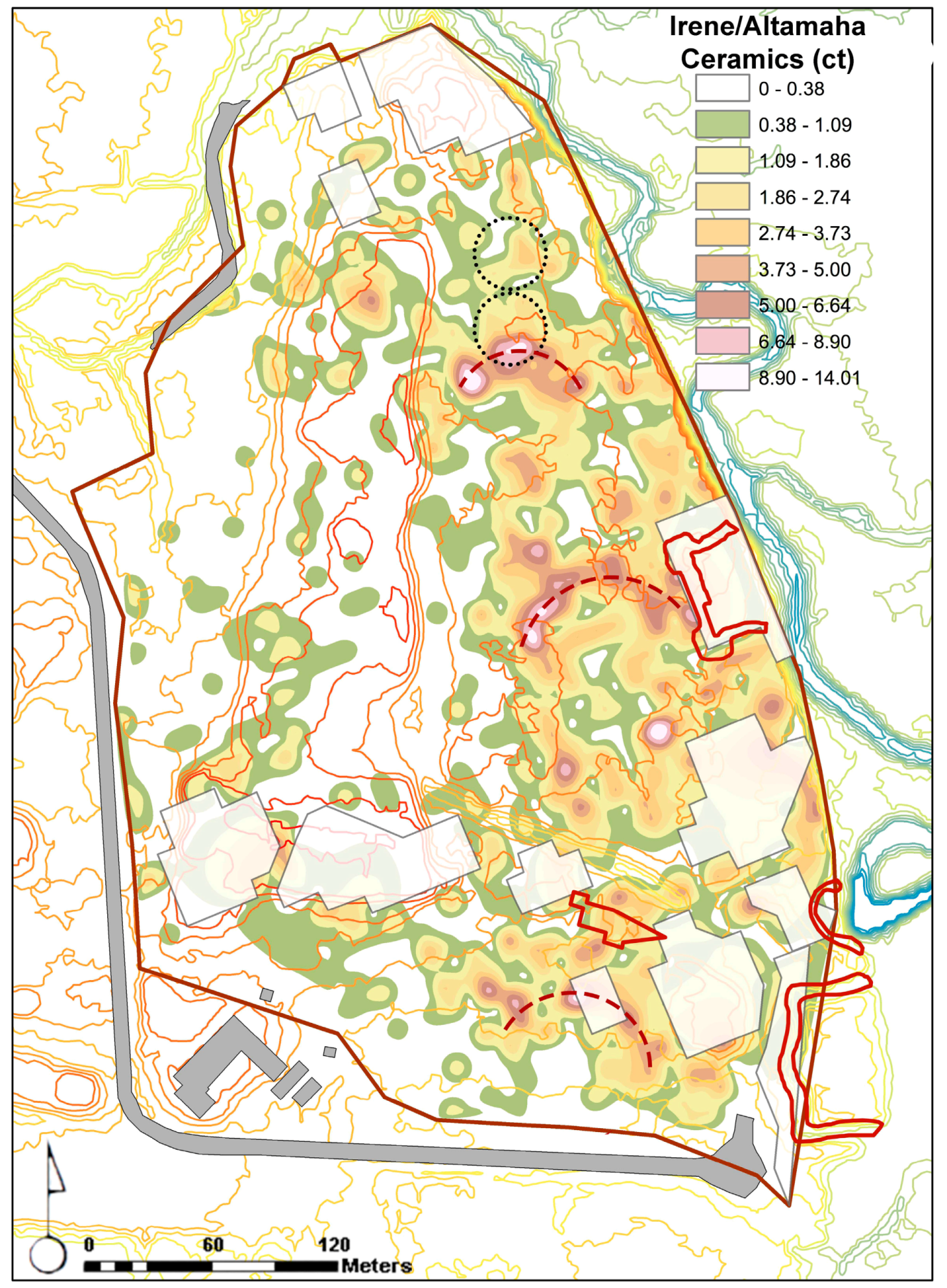
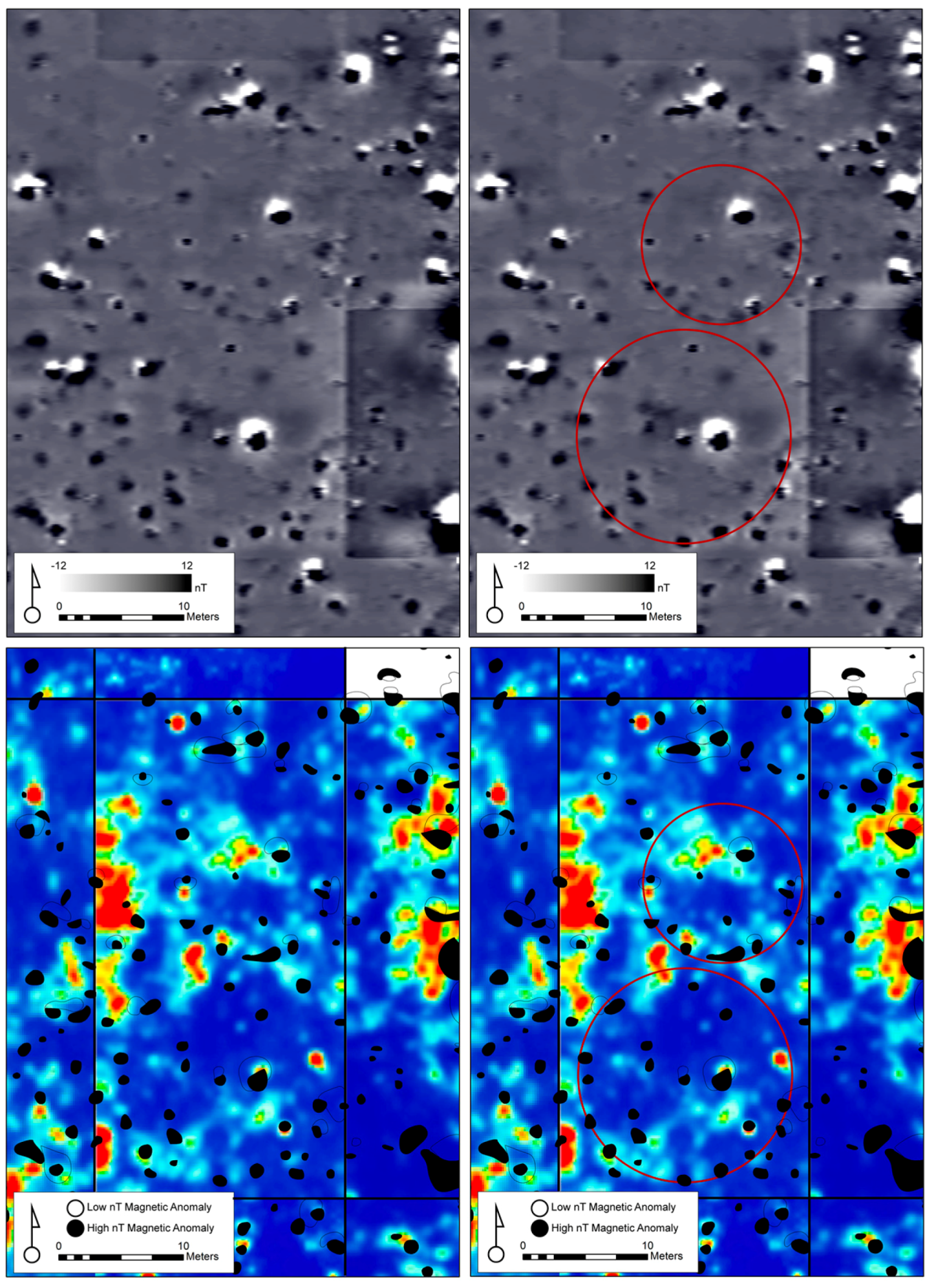
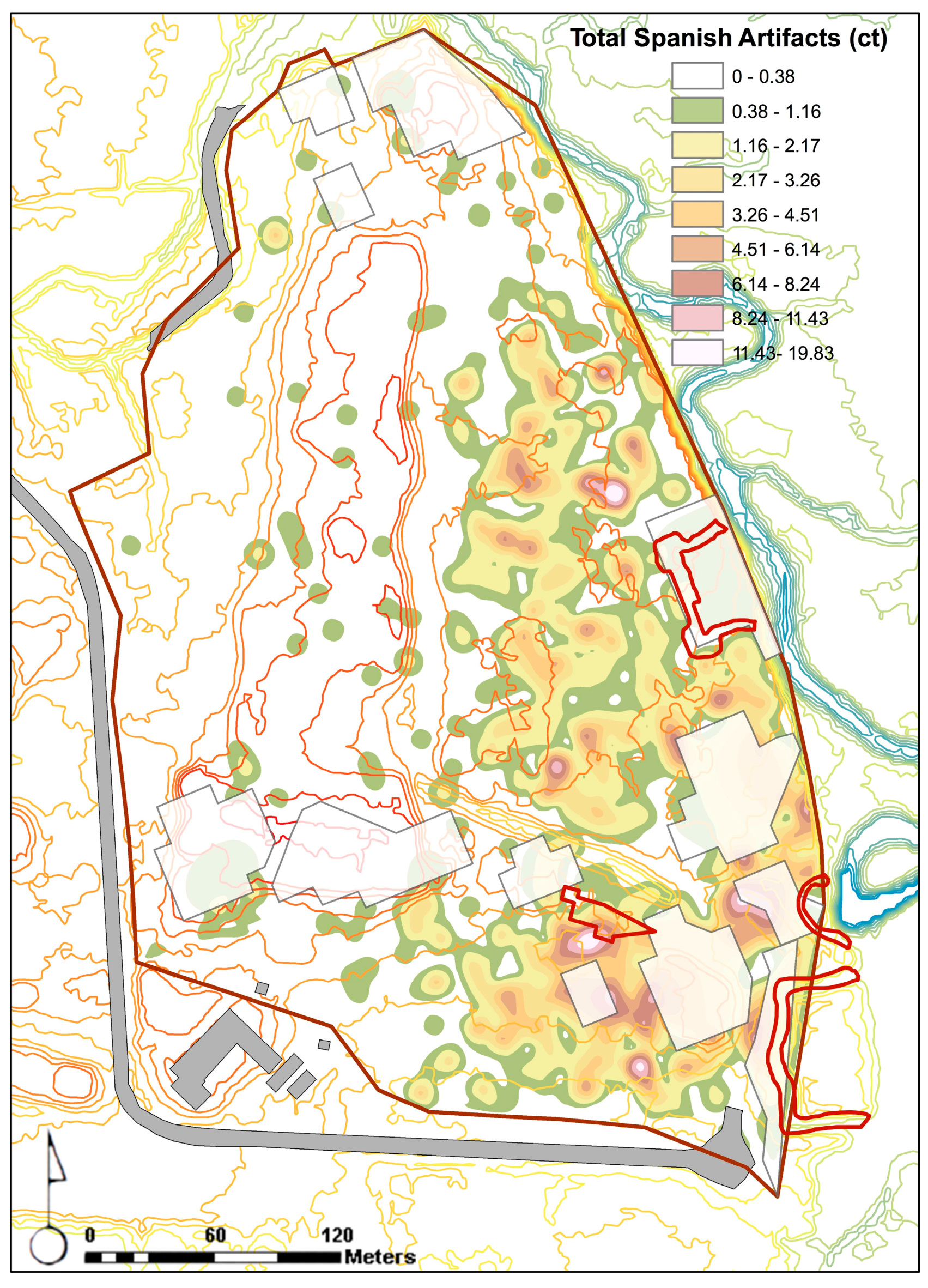

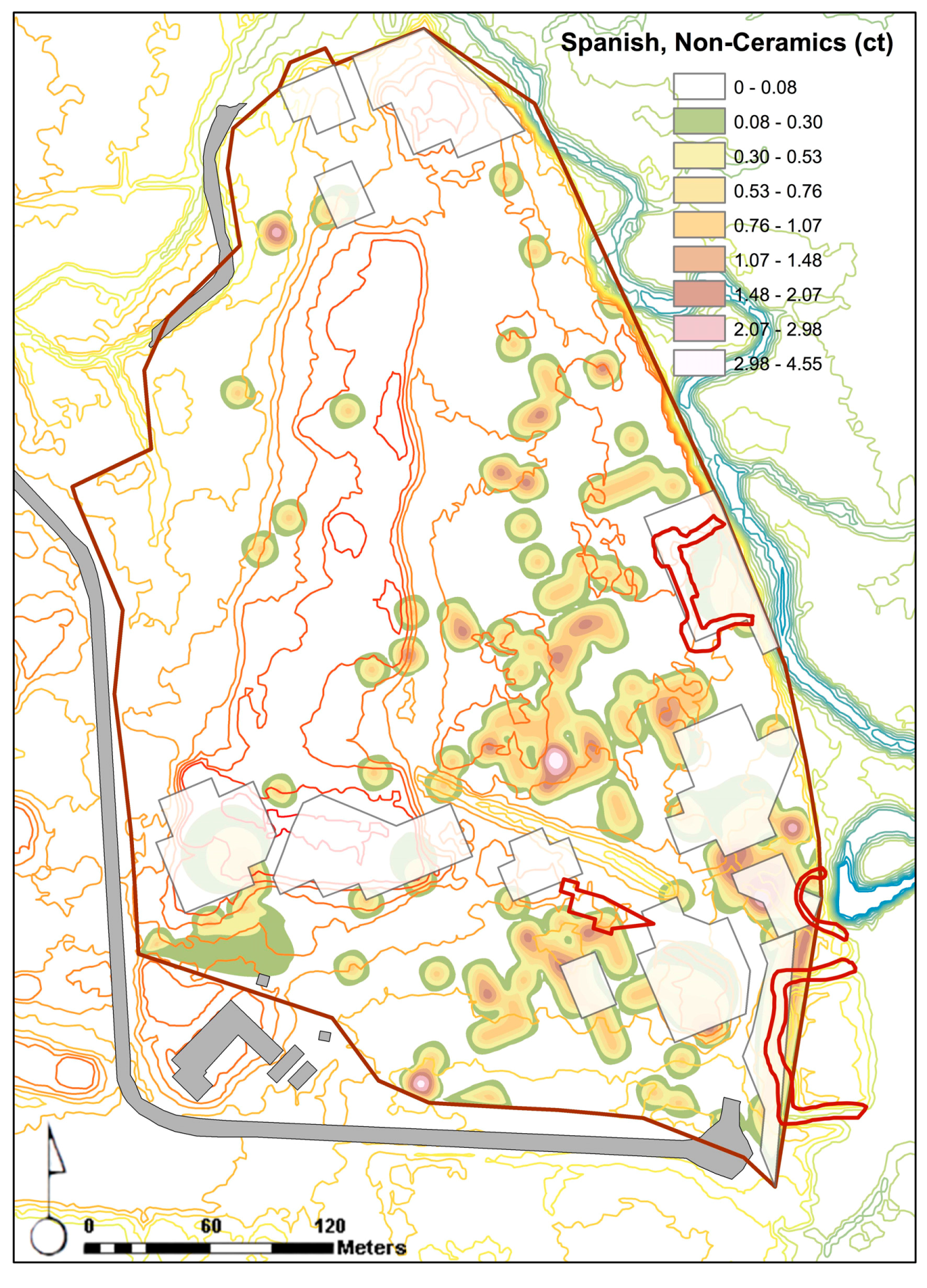
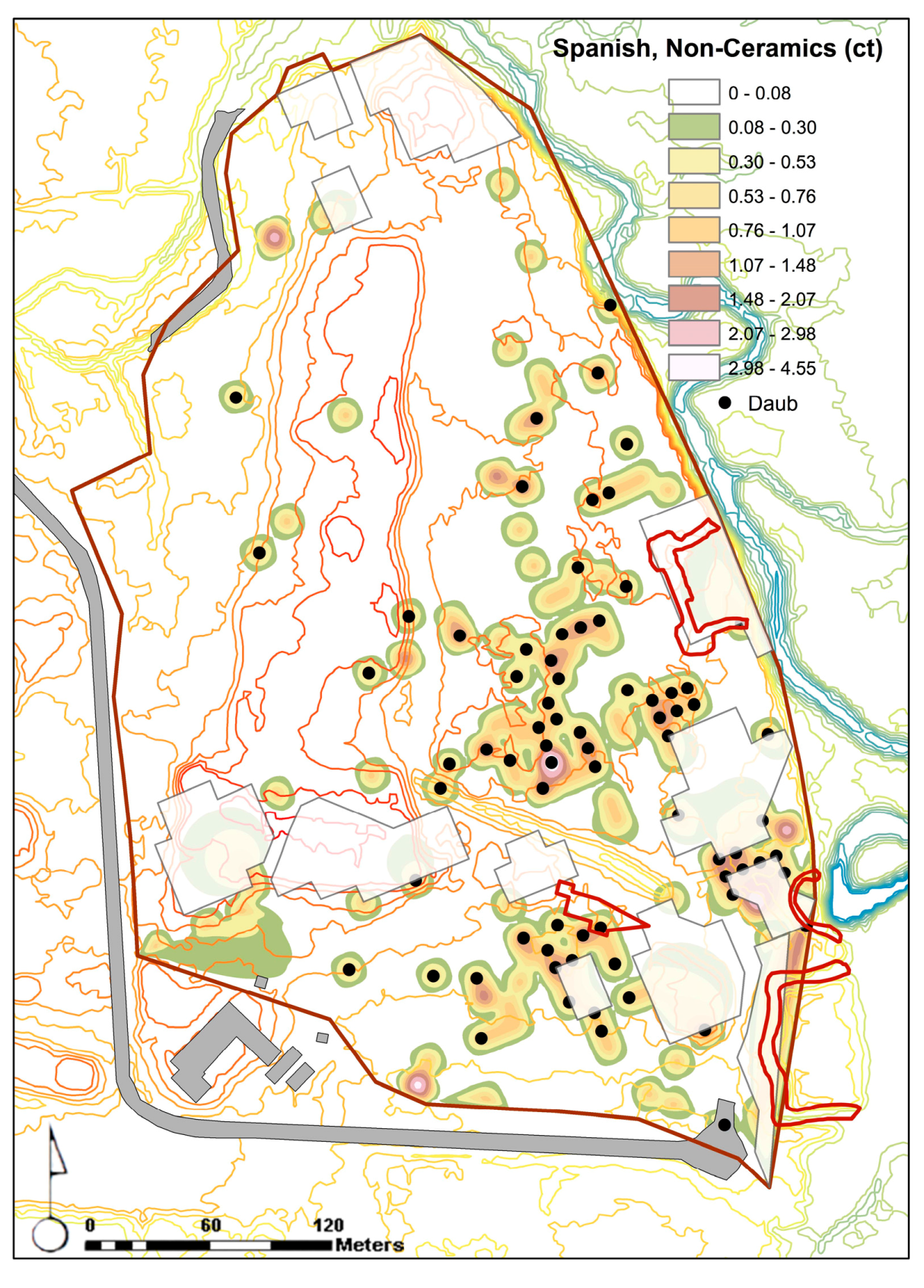
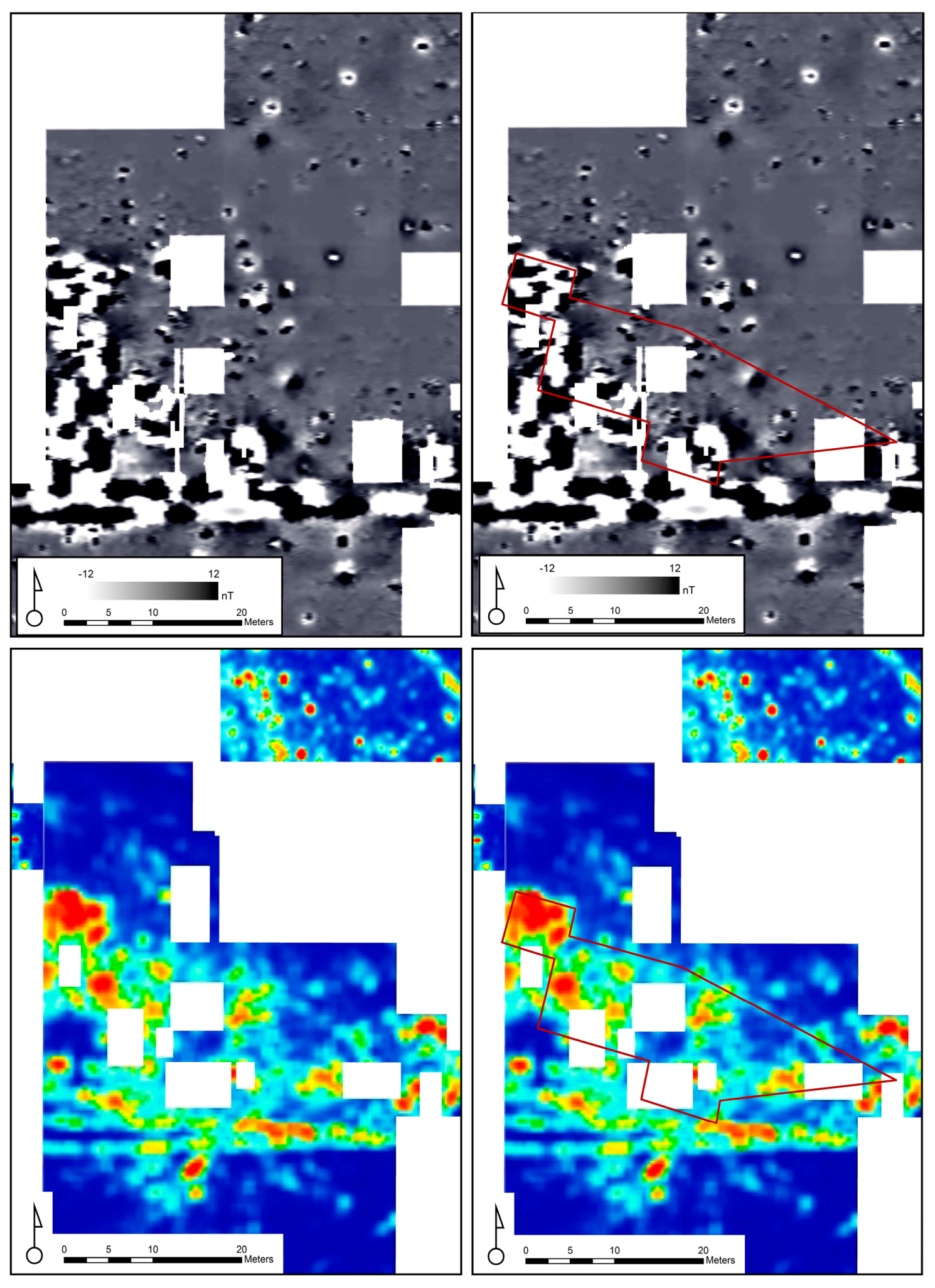
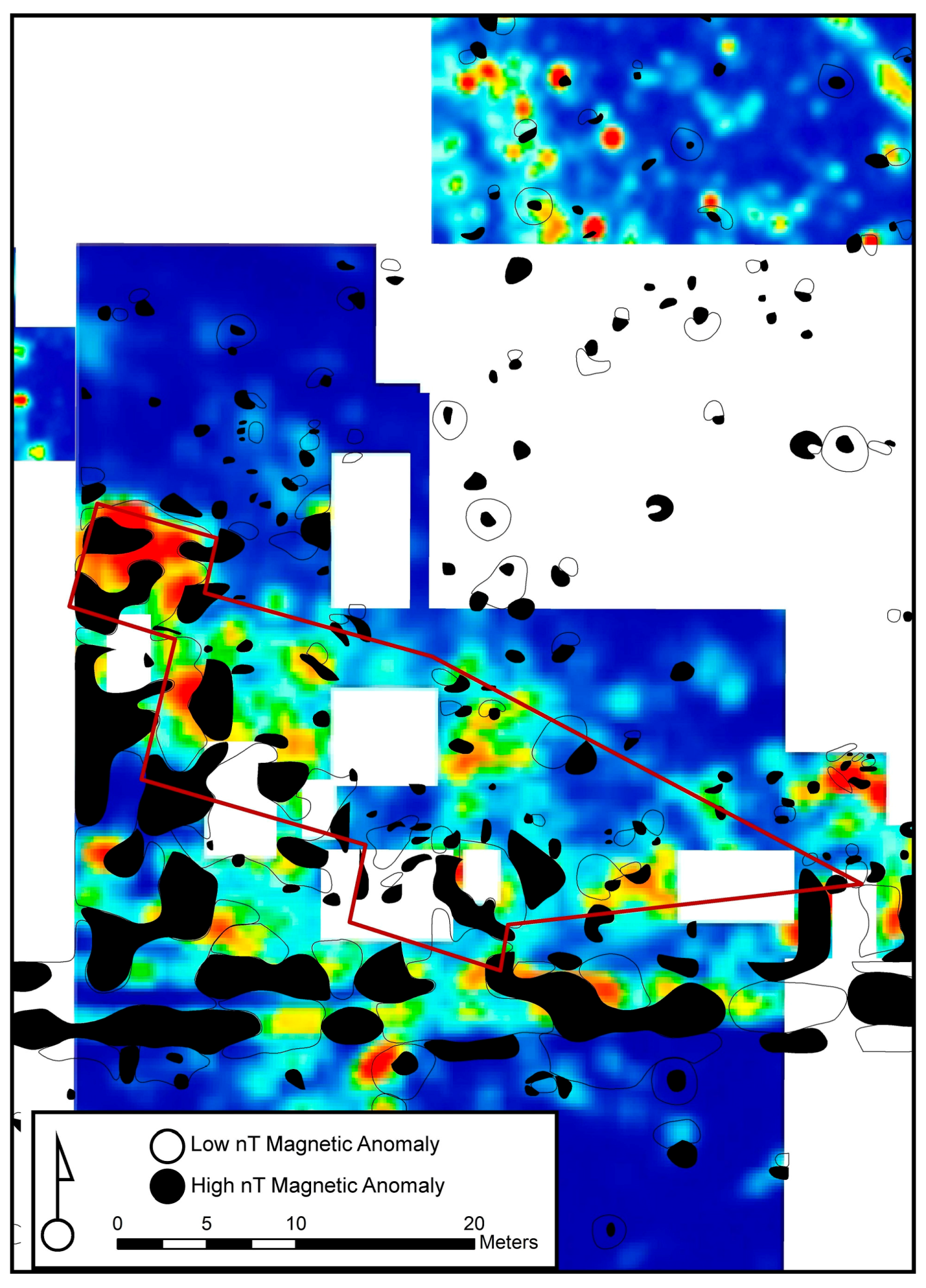
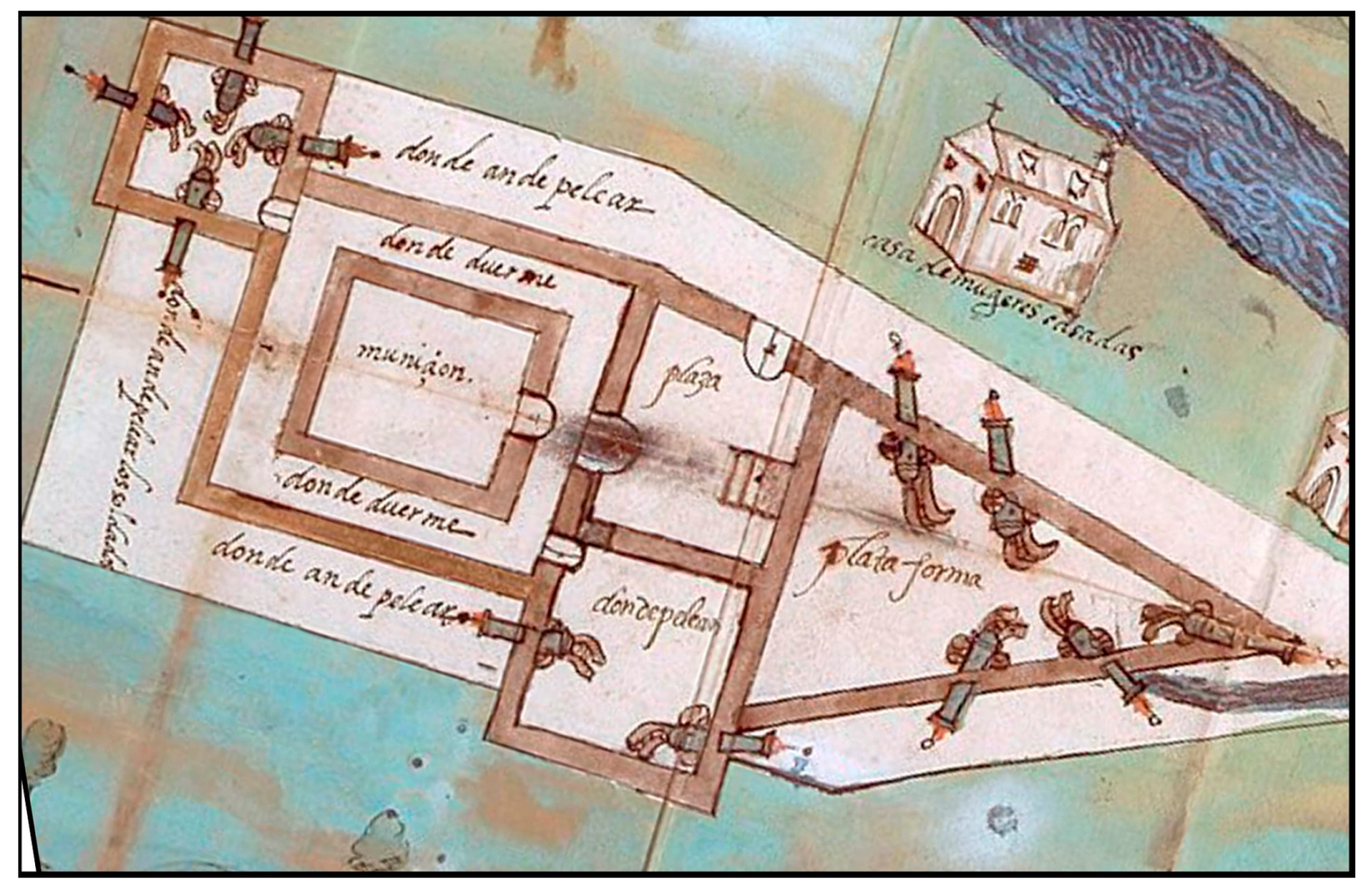
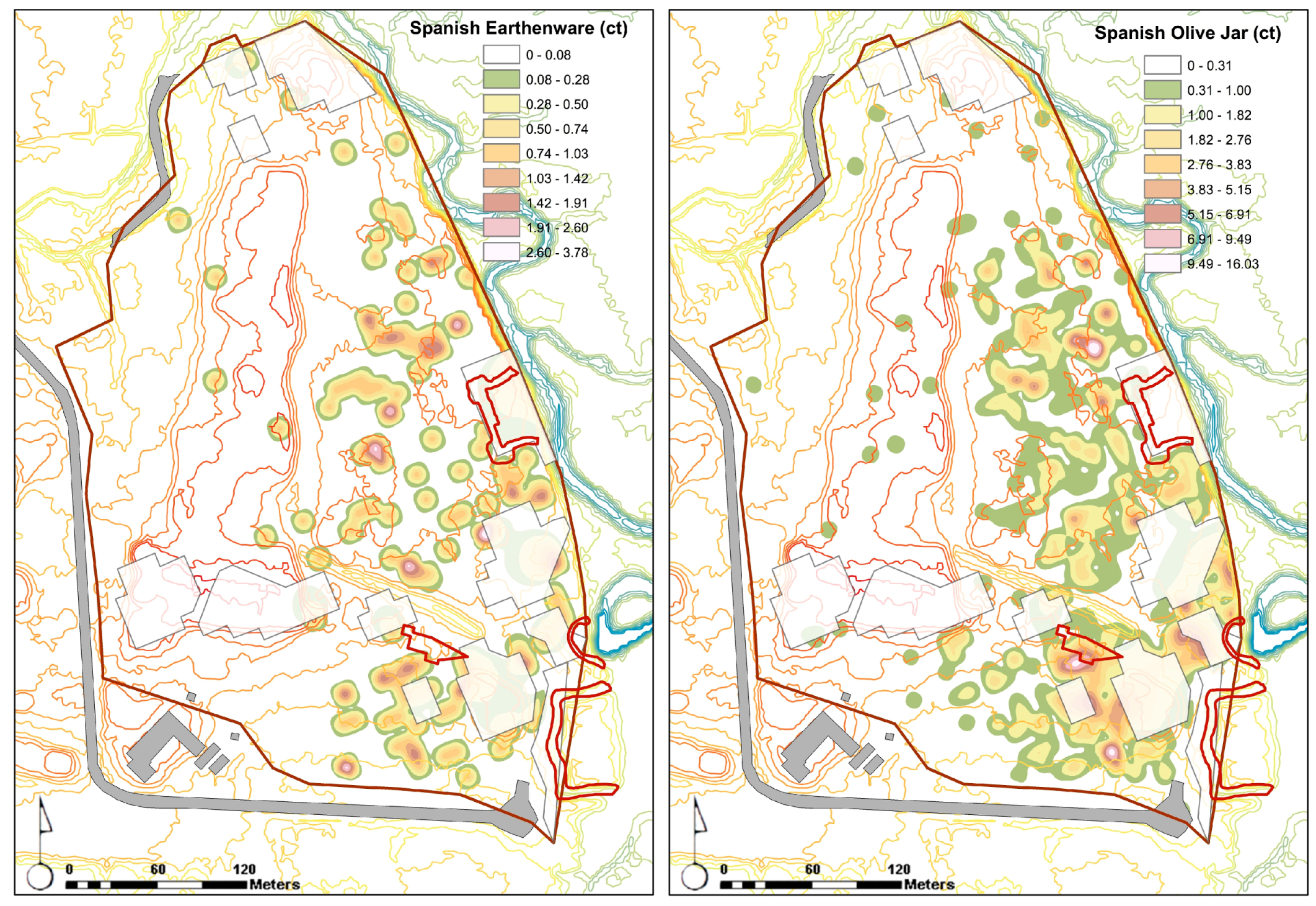
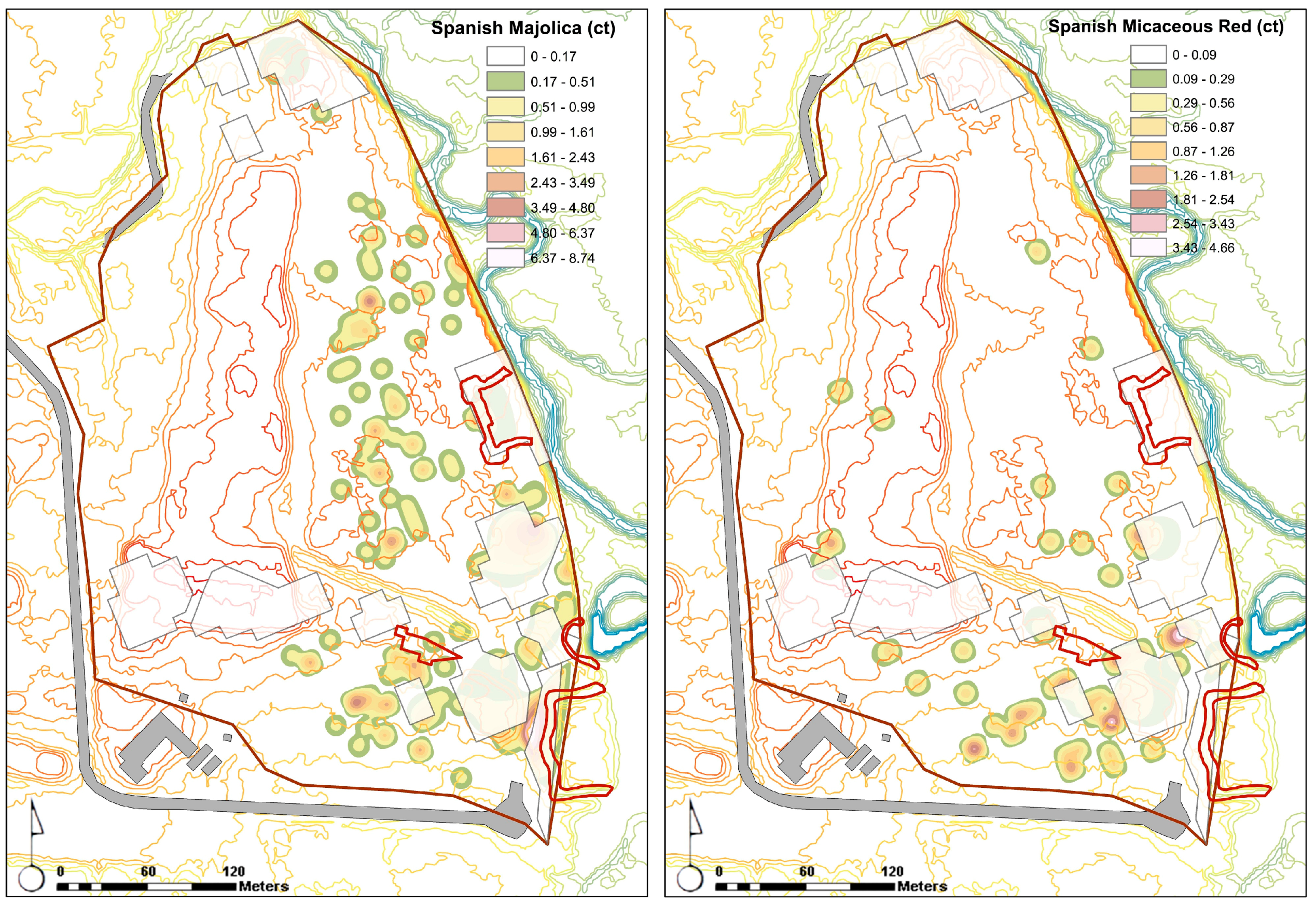
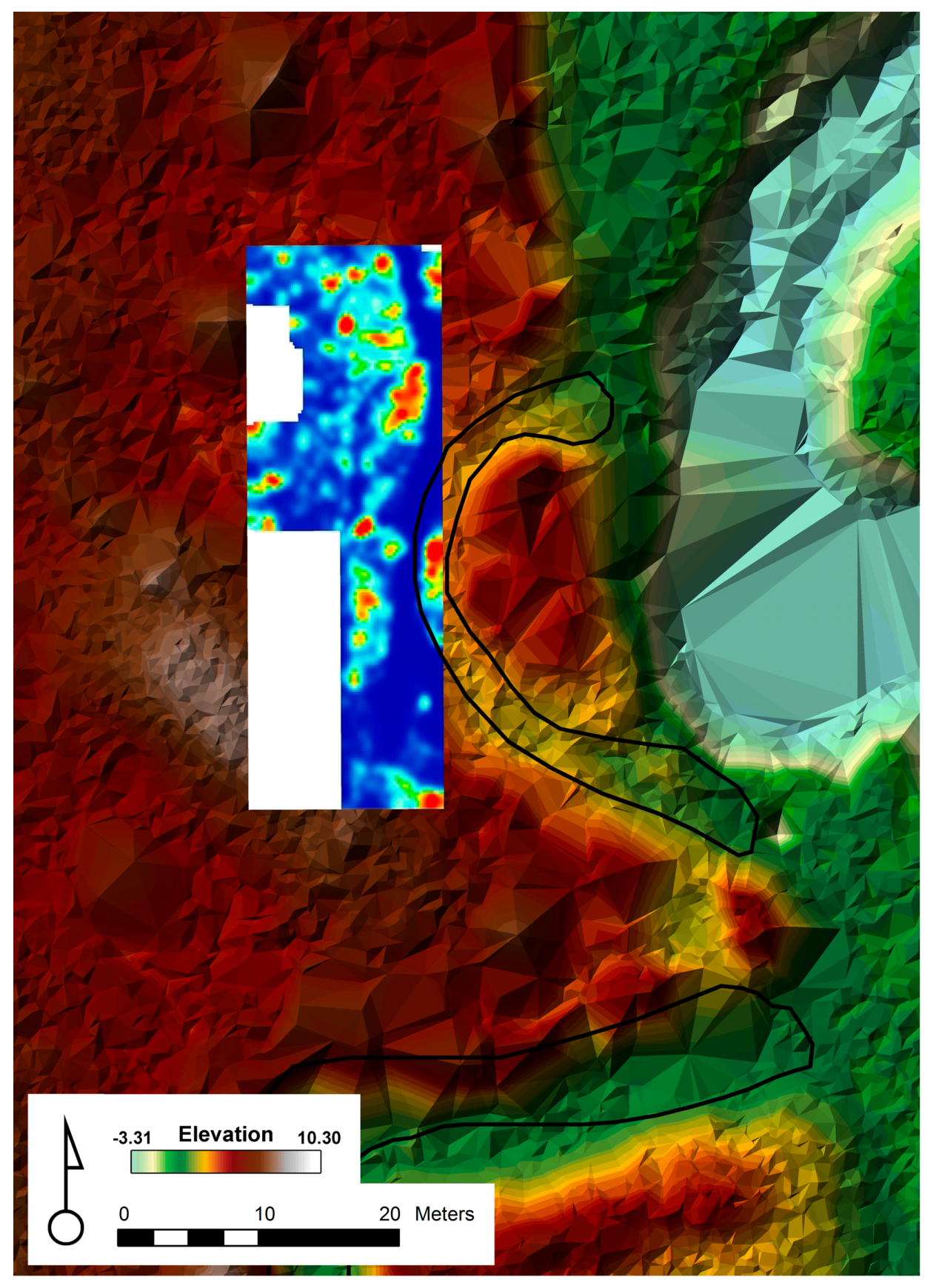
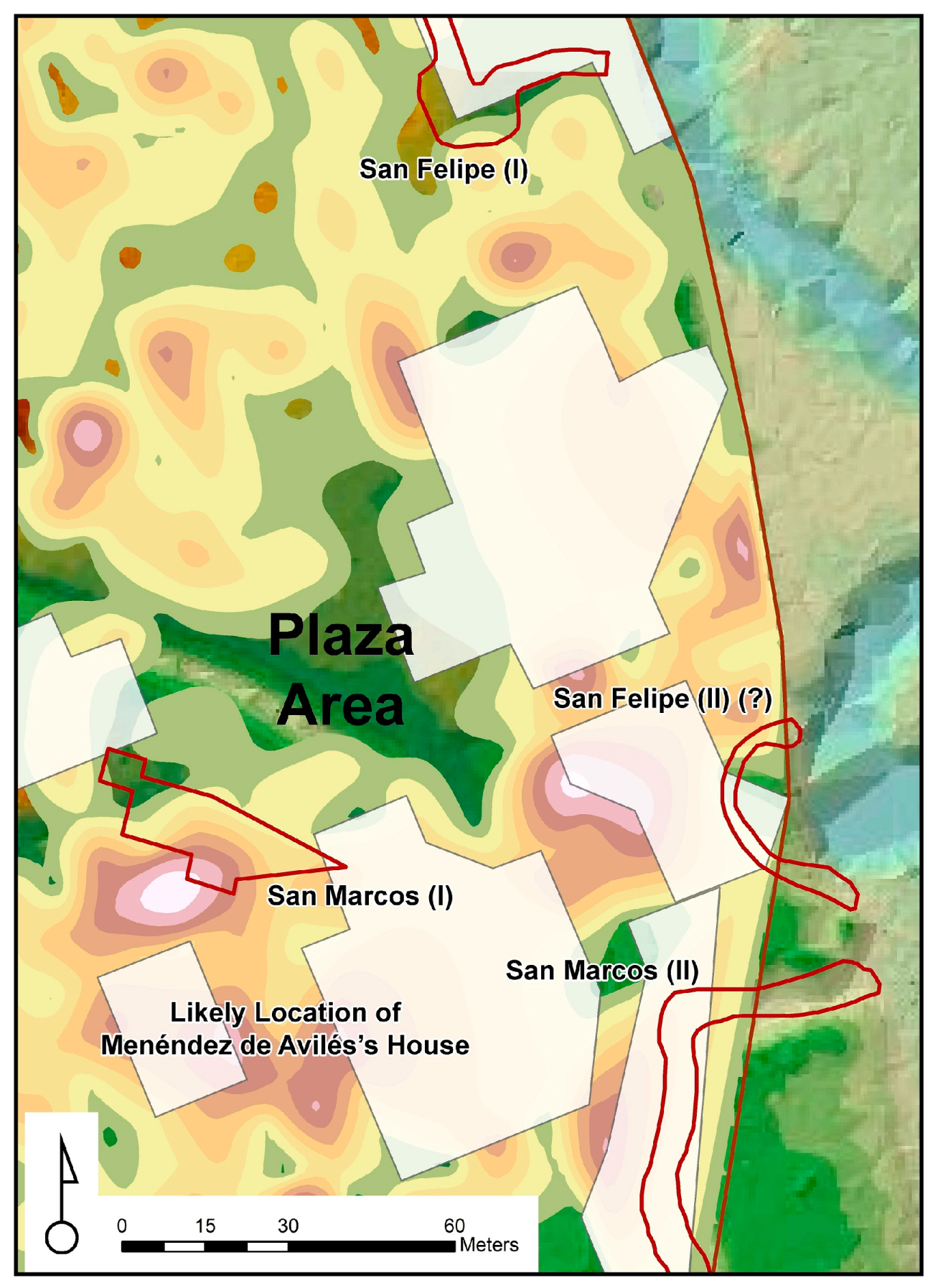
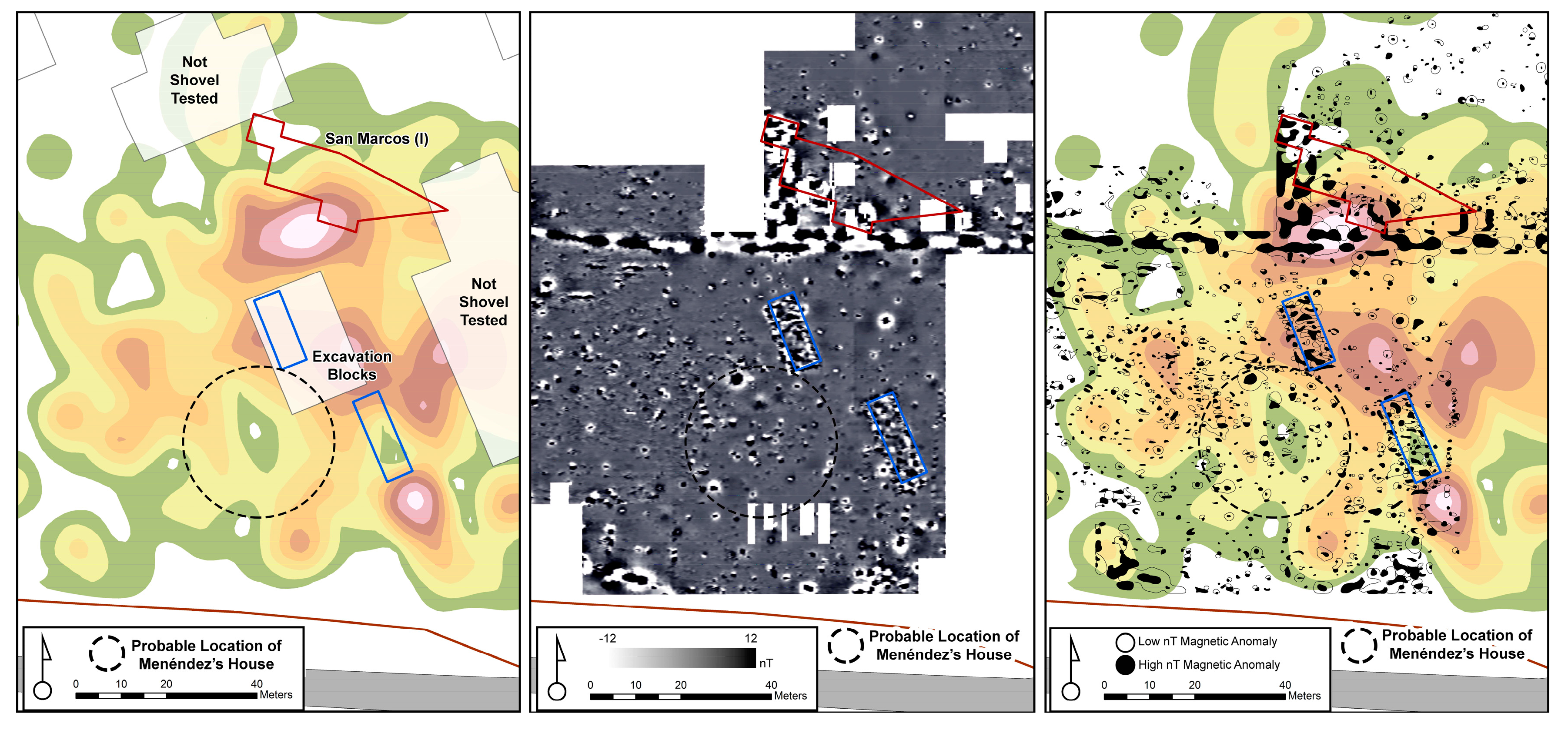
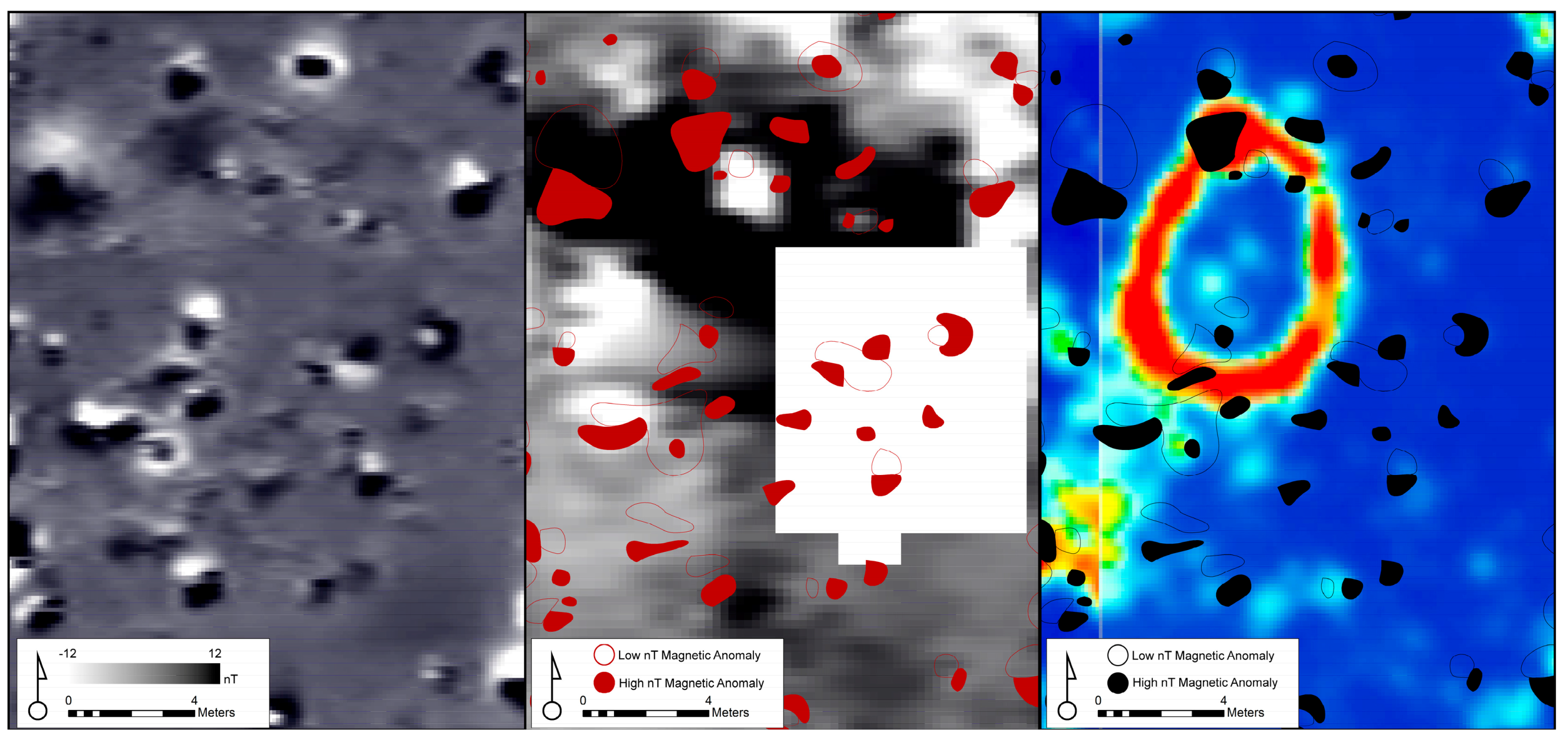

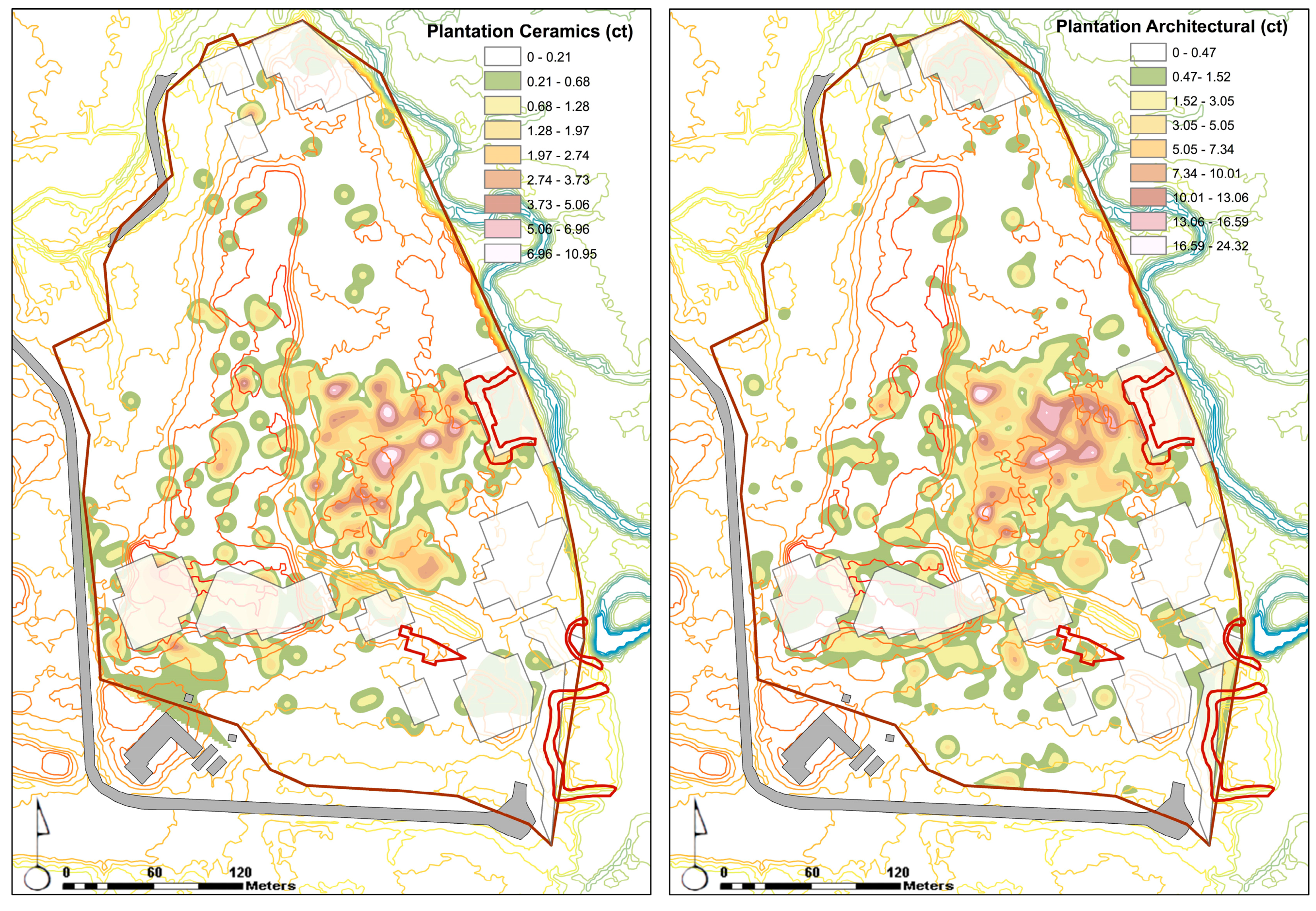
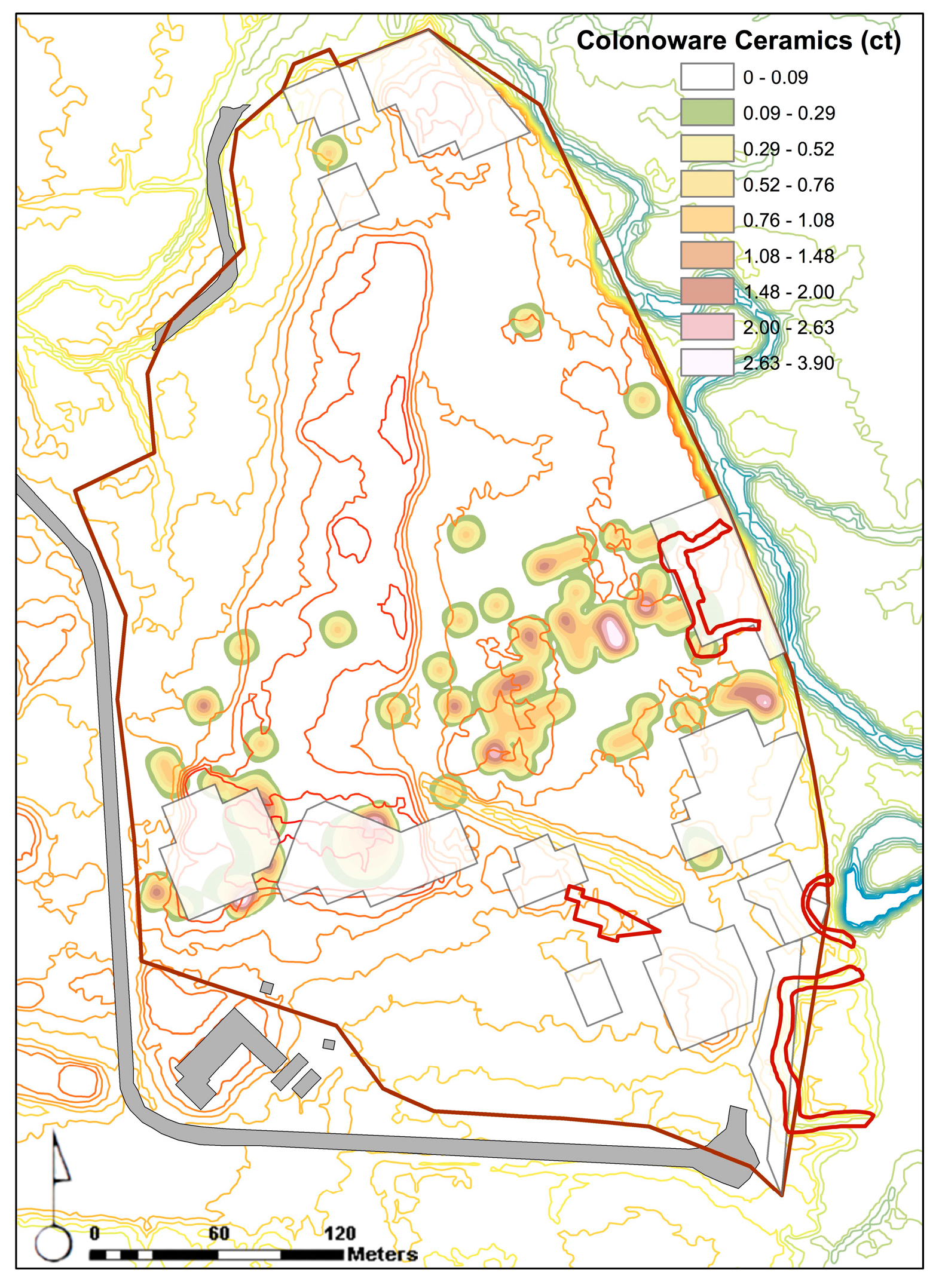
© 2018 by the authors. Licensee MDPI, Basel, Switzerland. This article is an open access article distributed under the terms and conditions of the Creative Commons Attribution (CC BY) license (http://creativecommons.org/licenses/by/4.0/).
Share and Cite
Thompson, V.D.; DePratter, C.B.; Lulewicz, J.; Lulewicz, I.H.; Roberts Thompson, A.D.; Cramb, J.; Ritchison, B.T.; Colvin, M.H. The Archaeology and Remote Sensing of Santa Elena’s Four Millennia of Occupation. Remote Sens. 2018, 10, 248. https://doi.org/10.3390/rs10020248
Thompson VD, DePratter CB, Lulewicz J, Lulewicz IH, Roberts Thompson AD, Cramb J, Ritchison BT, Colvin MH. The Archaeology and Remote Sensing of Santa Elena’s Four Millennia of Occupation. Remote Sensing. 2018; 10(2):248. https://doi.org/10.3390/rs10020248
Chicago/Turabian StyleThompson, Victor D., Chester B. DePratter, Jacob Lulewicz, Isabelle H. Lulewicz, Amanda D. Roberts Thompson, Justin Cramb, Brandon T. Ritchison, and Matthew H. Colvin. 2018. "The Archaeology and Remote Sensing of Santa Elena’s Four Millennia of Occupation" Remote Sensing 10, no. 2: 248. https://doi.org/10.3390/rs10020248
APA StyleThompson, V. D., DePratter, C. B., Lulewicz, J., Lulewicz, I. H., Roberts Thompson, A. D., Cramb, J., Ritchison, B. T., & Colvin, M. H. (2018). The Archaeology and Remote Sensing of Santa Elena’s Four Millennia of Occupation. Remote Sensing, 10(2), 248. https://doi.org/10.3390/rs10020248





